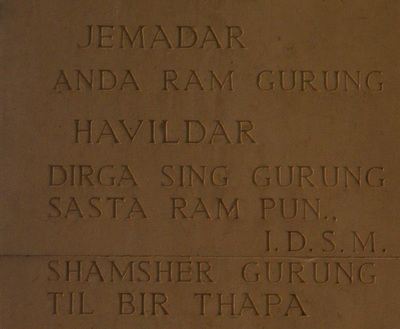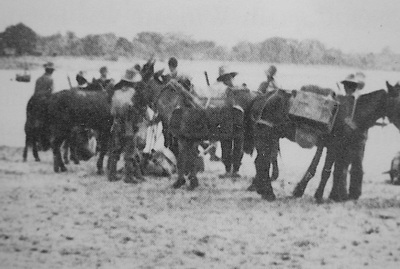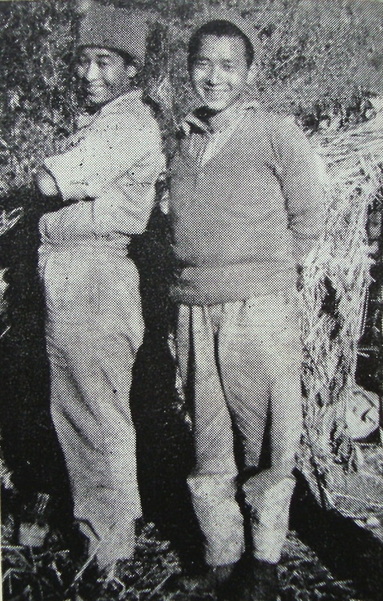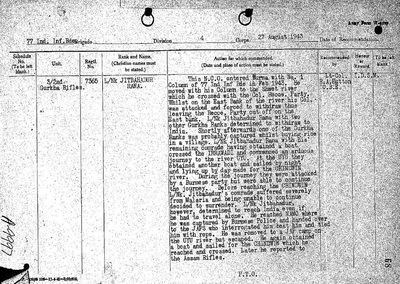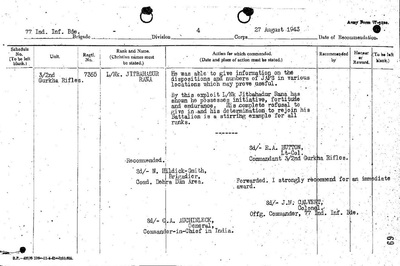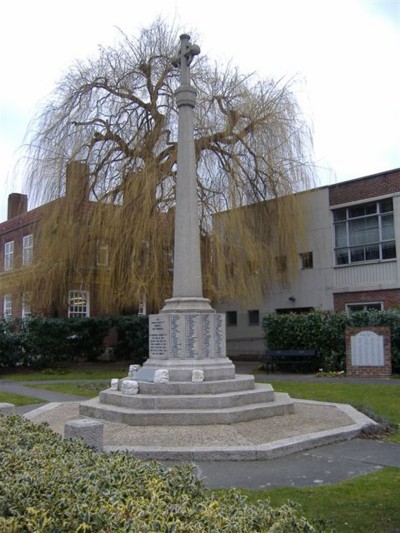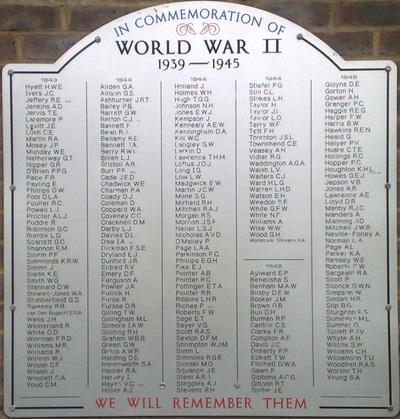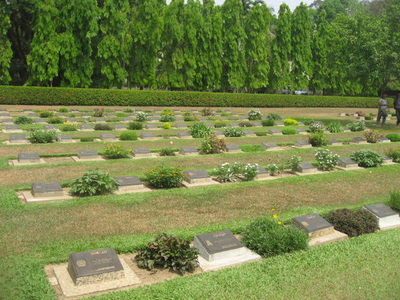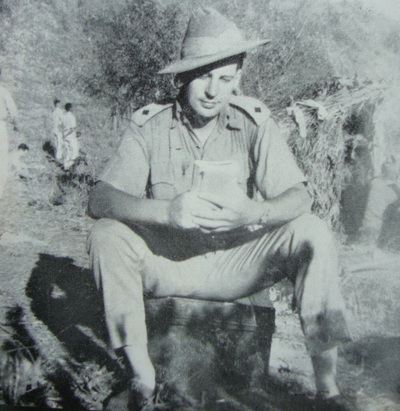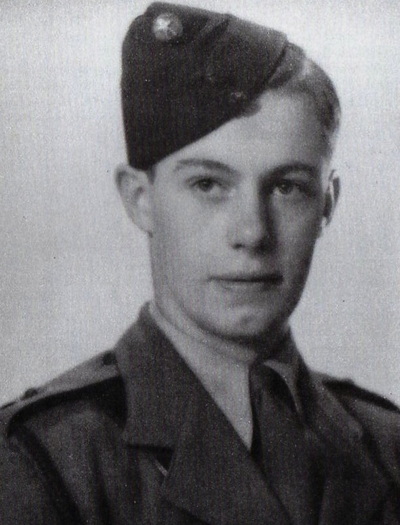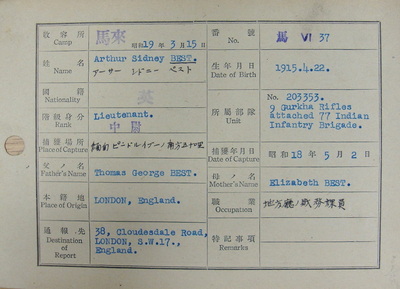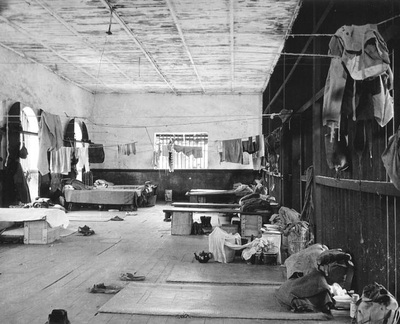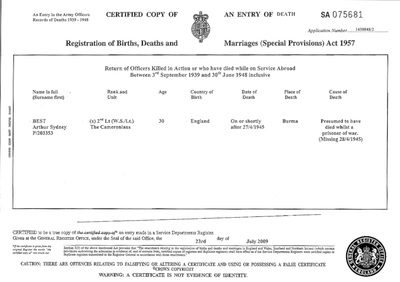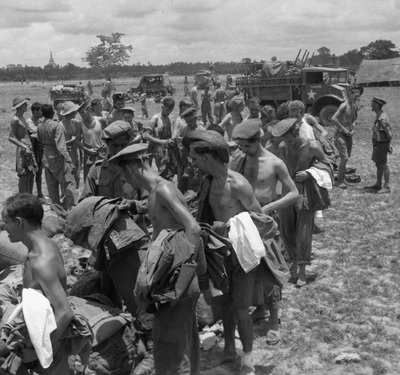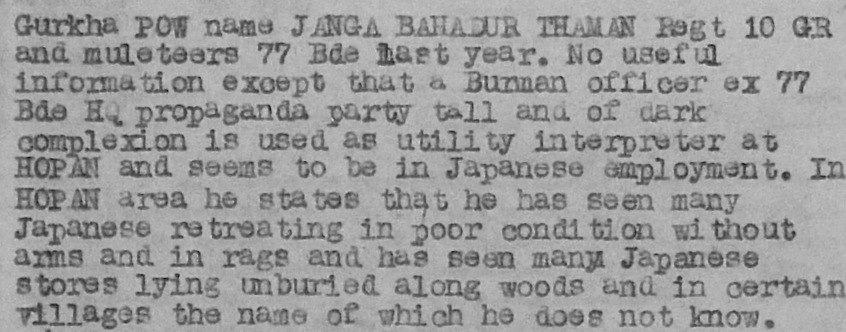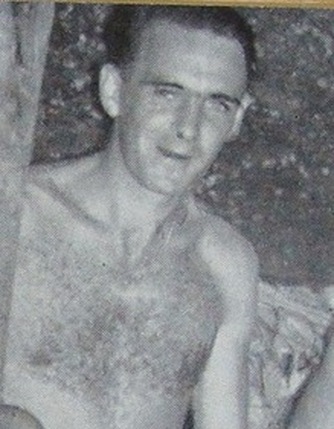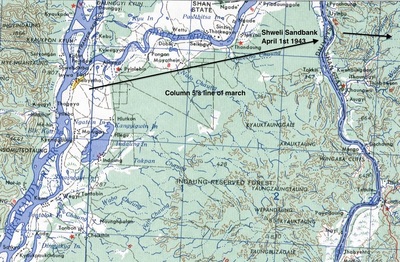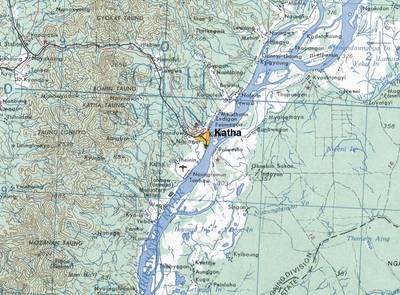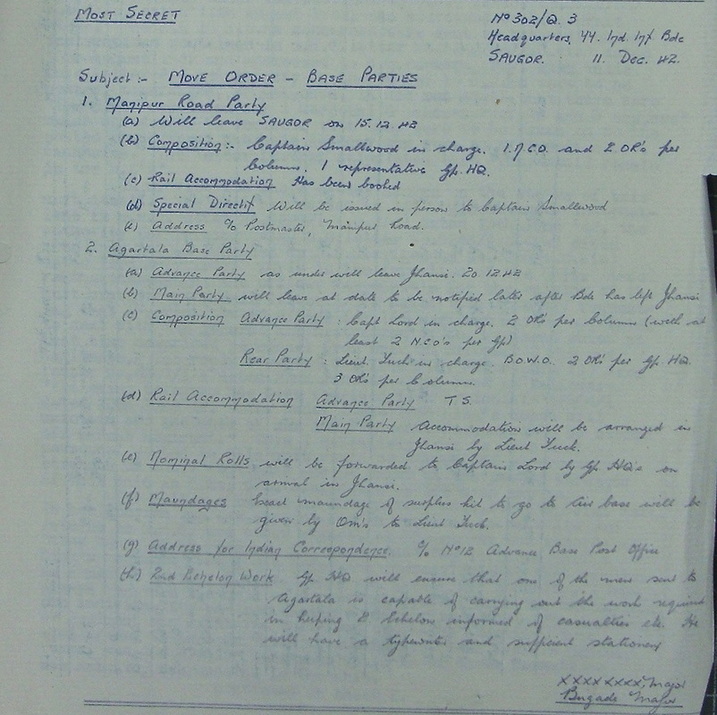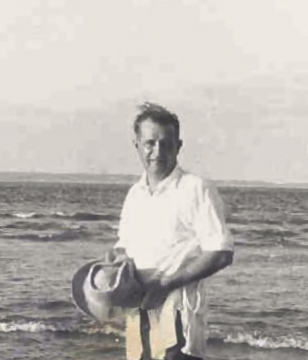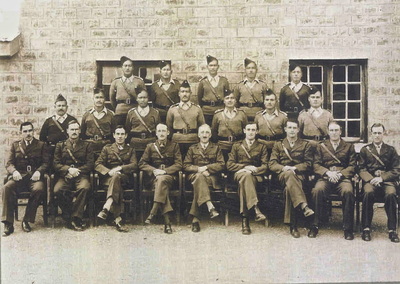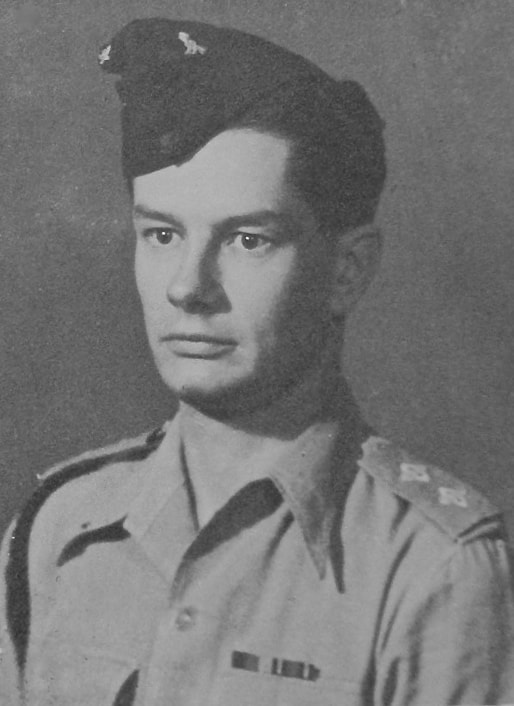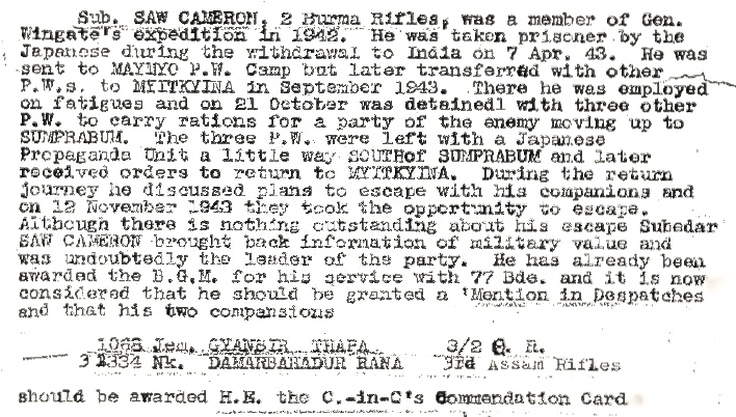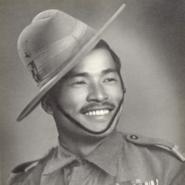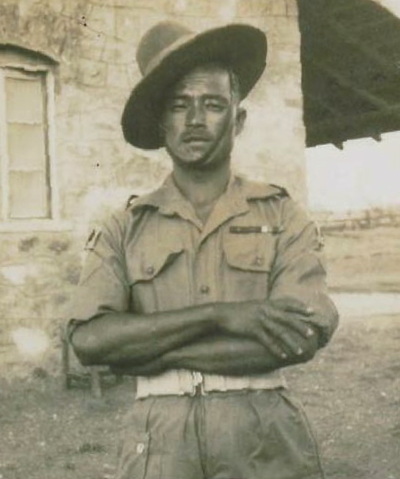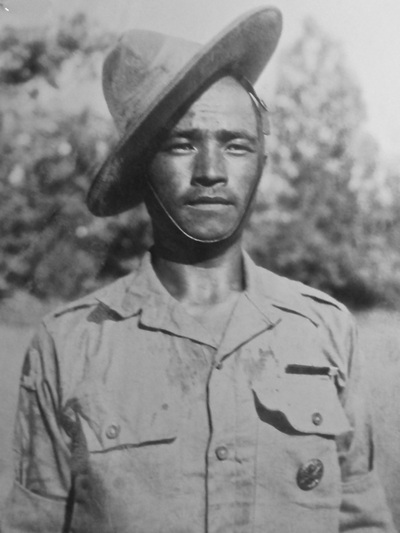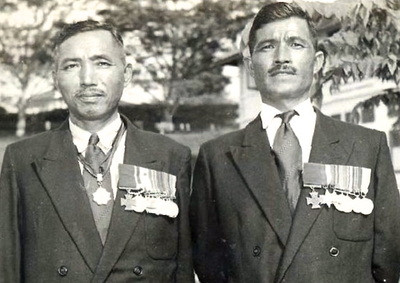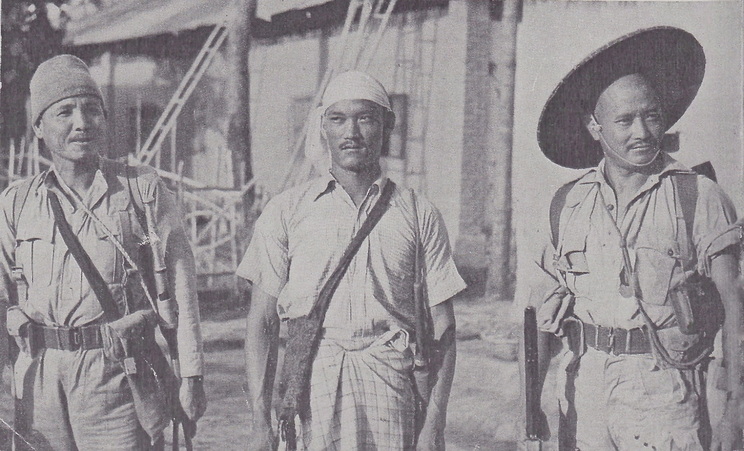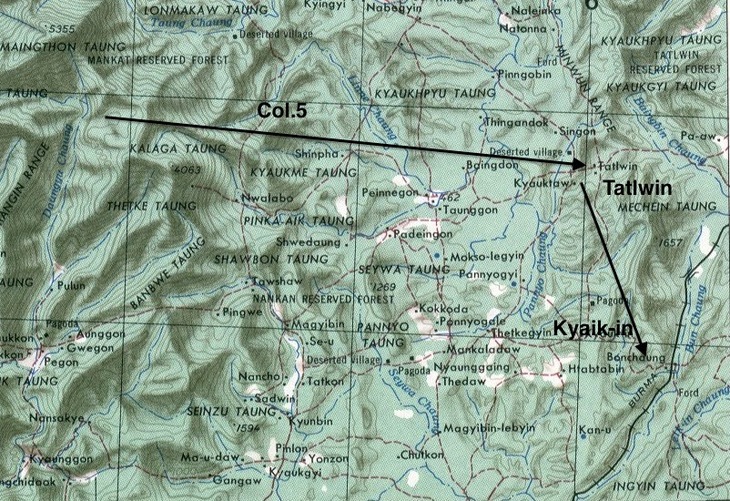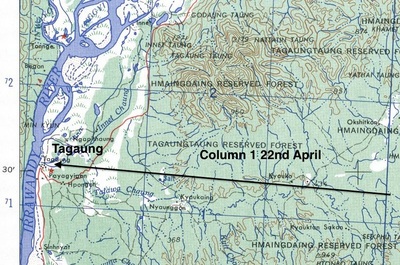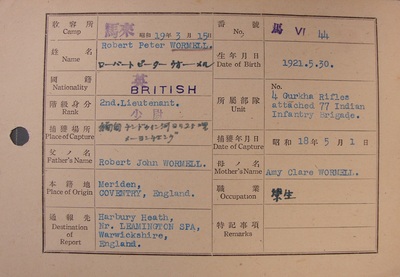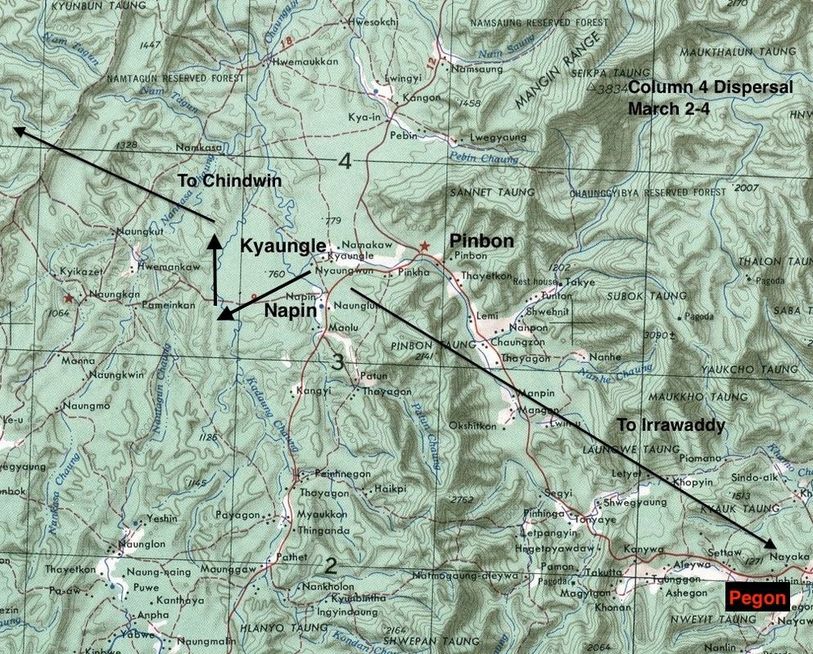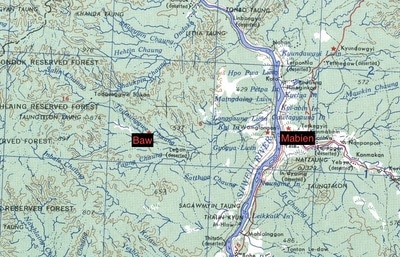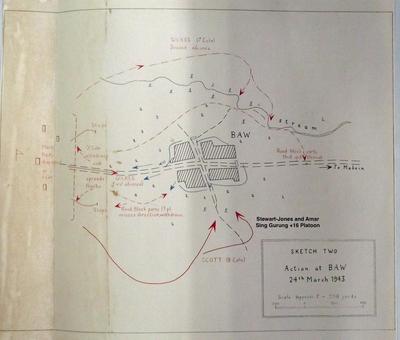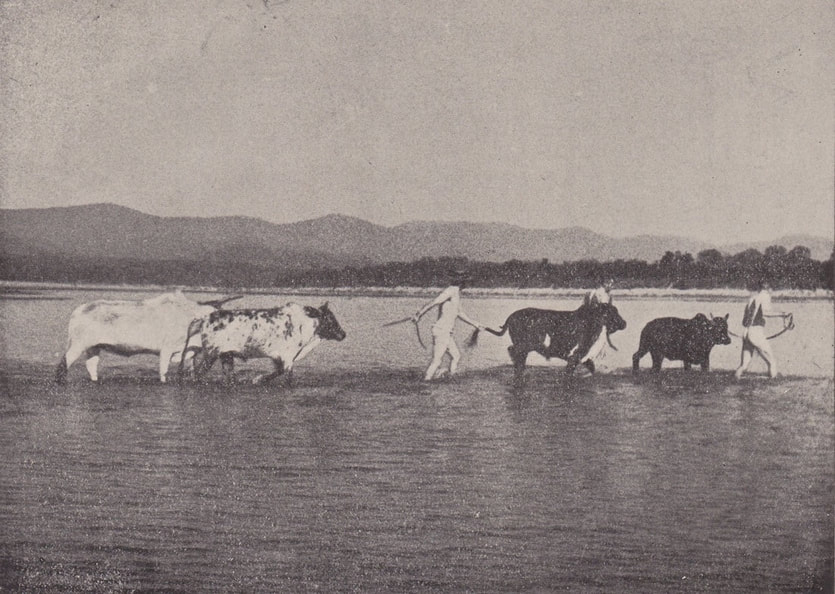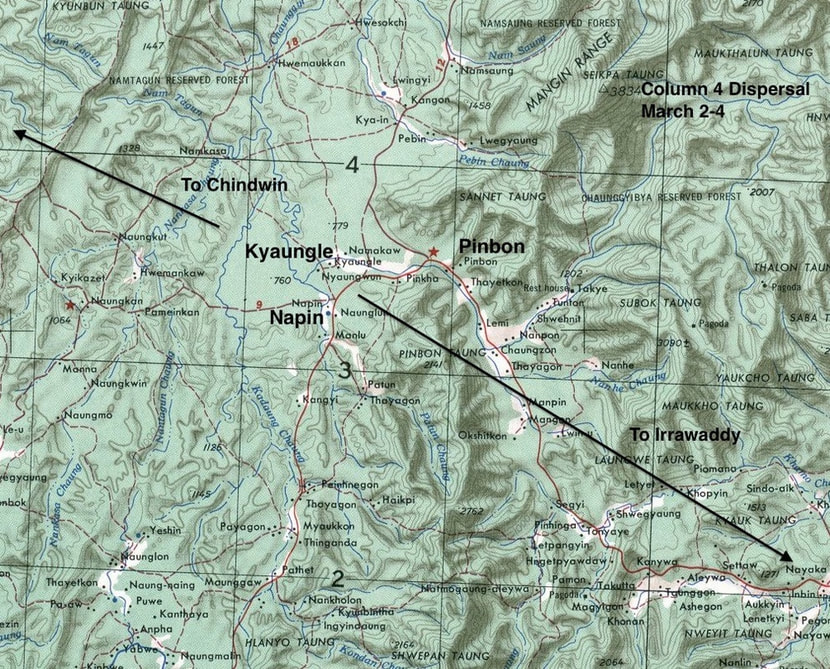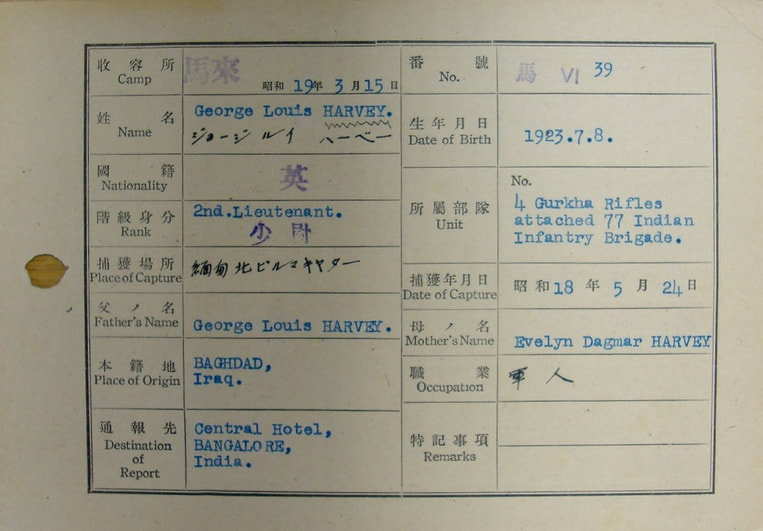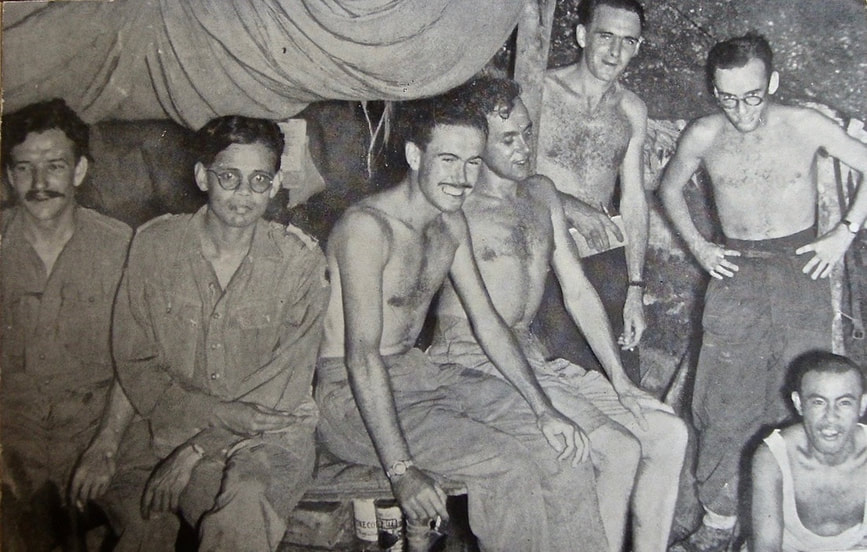Roll Call, the Gurkhas of Operation Longcloth
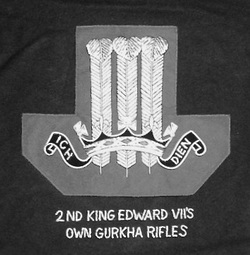
There can be no doubt that the Gurkha sections of 77th Brigade were used by Wingate as a 'feint' to confuse the Japanese about the real route to be taken by and intentions of the Northern Section and their demolition squads. Gurkha Columns 1 and 2 were sent off in a southerly direction as the operation began in February 1943, with the direct instructions to make themselves known to the enemy and the local village spies, as they moved openly toward the rail station at Kyaikthin.
Some commentators have remarked upon the callous nature in which Wingate used the Gurkhas as a diversion and suggested that he would never have dared use the 13th Kings in the same way. There is no doubt that Gurkha casualties were high from these two columns, but when you analyse the overall casualties for the operation, they do not stand out as overly exceptional, with similar numbers of British troops being lost.
The ultimate commitment and bravery of the Gurkha Rifleman on Operation Longcloth cannot be called in to question and the men of the 3/2 Gurkha Rifles upheld the traditions of the regiment.
The battalion had left it's Indian base in the early summer of 1942 and joined Chindit training at Saugor. The regimental letter included a short description of the unit and it's new role:
Alexander's Battalion.
News from this Battalion is very scarce. They live in the backwoods and are immersed in the toughest possible training. A route march of 200 miles is a fairly normal occurrence for them. They have no comforts, no homes, no paper and probably no time for writing letters.
During the recent rains they were overtaken by serious floods and the battalion lost a good deal of its property. This occurred at night and I understand the battalion had to take shelter in the nearby trees. Some of the men did useful rescue work.
After months spent on mechanisation they suddenly lost their vehicles and had to adopt mules. A vast mob of untrained mules, which took some handling and breaking-in. This proved to be a complete reversal of their previous training, but the battalion has got down to it and before long we should be getting some interesting news from them.
Those who cast a gloomy eye on the present physique of Goorkha recruits, should get some comfort from the way the recruits in this battalion are standing up to what is probably the toughest training any battalion has undergone.
General MacDonald who recently saw them at work, was full of praise for these men.
Featured below is my Roll Call for some of the men who made up the strength of 3/2 Gurkha Rifles in 1942/43. I have included all the information that is known about the soldier in question, this could literally be one sentence, but on occasion may well be more substantial in detail. I have chosen to list these men by their given name rather than the clan or tribe he represented.
Jemadar Anda Ram Gurung. The junior commander of the Gurkha section led by Captain George Silcock in Column 3. This unsung hero of Mike Calvert's unit led his men with great commitment and passion, gaining the well-meaning nickname of 'Under Arm' from the British Gurkha officers in the column.
Lieutenant Harold James remembered him thus:
"I was glad to be given a decent job and also that 13 Platoon was to be in my charge. The platoon's Gurkha Officer was Jemadar Anda Ram Gurung. He was universally liked and affectionately called 'Under Arm'. Slim, plucky, ugly but with a transforming smile when he laughed, which was very often, he was a man I came to know well and could really trust."
Sadly, having successfully reached the safety of India with Column 3 in April, Anda Ram Gurung succumbed to a severe bout of malaria whilst at home in Nepal and died on 24th June 1943. Here are his CWGC details:
http://www.cwgc.org/find-war-dead/casualty/2503458/ANDA%20RAM%20GURUNG
Naik Devsur Ale. This soldier was with Chindit Column 1 on Operation Longcloth. After dispersal was called in late March 1943, Column 1 found themselves further east than any other Chindit unit, their journey home would be long and arduous. Around the third week in April, the Column attempted to cross the Irrawaddy River near a village called Singyat.
Naik Devsur Ale was given the task of setting up a rearguard position to protect the men as they crossed. Subedar-Major Siblal Thapa recalled:
"The last boat with Naik Devsur Ale's platoon was only about 50 yards from our side of the river when we were attacked from all angles. The enemy fired on the boats; the only survivors were Devsur and one other Rifleman. A few men from that last platoon were left on the far side with Subedar Padanbahadur's party and did not cross the river that day."
I do not possess any more information about Devsur Ale, but it seems likely that he returned safely to India in 1943.
Naik Harka Bahadur. This NCO originally came from the 10th Gurkha Rifles as part of a draft of men sent to serve as muleteers on Operation Longcloth. He was posted to Column 8 and served under Lieutenant Dominic Fitzgerald Neill whilst in Burma. After dispersal was called in late March 1943, Lieutenant Neill and his Gurkhas made their way out westward towards India. Their journey was long and tortuous and on more than one occasion they had to fight off enemy attacks.
As they approached the final few miles of their journey back to the Chindwin River, Harka Bahadur fell ill, suffering from malaria and exhaustion. It is suggested that he may not have made it back to India and died from his illness on 15 May 1943. However, I cannot find any details for his death on the CWGC website and there is no record of his demise within Lieutenant Neill's memoir, 'One More River'. I sincerely hope that Naik Harka Bahadur made it safely home to Nepal in 1943 and went on to enjoy a long and prosperous life.
Havildar Budhiman. This Gurkha soldier was also part of Lieutenant Neill's Animal Transport Platoon in Column 8, in fact he was Neill's trusted right hand during the operation in 1943. Budhiman safely re-crossed the Chindwin River in early June 1943, leading the sick and wounded over in the first boat at the village of Sahpa, close to the town of Meine.
Here are some images relating to the above section of Gurkha stories, please click on any image to bring it forward on the page.
Some commentators have remarked upon the callous nature in which Wingate used the Gurkhas as a diversion and suggested that he would never have dared use the 13th Kings in the same way. There is no doubt that Gurkha casualties were high from these two columns, but when you analyse the overall casualties for the operation, they do not stand out as overly exceptional, with similar numbers of British troops being lost.
The ultimate commitment and bravery of the Gurkha Rifleman on Operation Longcloth cannot be called in to question and the men of the 3/2 Gurkha Rifles upheld the traditions of the regiment.
The battalion had left it's Indian base in the early summer of 1942 and joined Chindit training at Saugor. The regimental letter included a short description of the unit and it's new role:
Alexander's Battalion.
News from this Battalion is very scarce. They live in the backwoods and are immersed in the toughest possible training. A route march of 200 miles is a fairly normal occurrence for them. They have no comforts, no homes, no paper and probably no time for writing letters.
During the recent rains they were overtaken by serious floods and the battalion lost a good deal of its property. This occurred at night and I understand the battalion had to take shelter in the nearby trees. Some of the men did useful rescue work.
After months spent on mechanisation they suddenly lost their vehicles and had to adopt mules. A vast mob of untrained mules, which took some handling and breaking-in. This proved to be a complete reversal of their previous training, but the battalion has got down to it and before long we should be getting some interesting news from them.
Those who cast a gloomy eye on the present physique of Goorkha recruits, should get some comfort from the way the recruits in this battalion are standing up to what is probably the toughest training any battalion has undergone.
General MacDonald who recently saw them at work, was full of praise for these men.
Featured below is my Roll Call for some of the men who made up the strength of 3/2 Gurkha Rifles in 1942/43. I have included all the information that is known about the soldier in question, this could literally be one sentence, but on occasion may well be more substantial in detail. I have chosen to list these men by their given name rather than the clan or tribe he represented.
Jemadar Anda Ram Gurung. The junior commander of the Gurkha section led by Captain George Silcock in Column 3. This unsung hero of Mike Calvert's unit led his men with great commitment and passion, gaining the well-meaning nickname of 'Under Arm' from the British Gurkha officers in the column.
Lieutenant Harold James remembered him thus:
"I was glad to be given a decent job and also that 13 Platoon was to be in my charge. The platoon's Gurkha Officer was Jemadar Anda Ram Gurung. He was universally liked and affectionately called 'Under Arm'. Slim, plucky, ugly but with a transforming smile when he laughed, which was very often, he was a man I came to know well and could really trust."
Sadly, having successfully reached the safety of India with Column 3 in April, Anda Ram Gurung succumbed to a severe bout of malaria whilst at home in Nepal and died on 24th June 1943. Here are his CWGC details:
http://www.cwgc.org/find-war-dead/casualty/2503458/ANDA%20RAM%20GURUNG
Naik Devsur Ale. This soldier was with Chindit Column 1 on Operation Longcloth. After dispersal was called in late March 1943, Column 1 found themselves further east than any other Chindit unit, their journey home would be long and arduous. Around the third week in April, the Column attempted to cross the Irrawaddy River near a village called Singyat.
Naik Devsur Ale was given the task of setting up a rearguard position to protect the men as they crossed. Subedar-Major Siblal Thapa recalled:
"The last boat with Naik Devsur Ale's platoon was only about 50 yards from our side of the river when we were attacked from all angles. The enemy fired on the boats; the only survivors were Devsur and one other Rifleman. A few men from that last platoon were left on the far side with Subedar Padanbahadur's party and did not cross the river that day."
I do not possess any more information about Devsur Ale, but it seems likely that he returned safely to India in 1943.
Naik Harka Bahadur. This NCO originally came from the 10th Gurkha Rifles as part of a draft of men sent to serve as muleteers on Operation Longcloth. He was posted to Column 8 and served under Lieutenant Dominic Fitzgerald Neill whilst in Burma. After dispersal was called in late March 1943, Lieutenant Neill and his Gurkhas made their way out westward towards India. Their journey was long and tortuous and on more than one occasion they had to fight off enemy attacks.
As they approached the final few miles of their journey back to the Chindwin River, Harka Bahadur fell ill, suffering from malaria and exhaustion. It is suggested that he may not have made it back to India and died from his illness on 15 May 1943. However, I cannot find any details for his death on the CWGC website and there is no record of his demise within Lieutenant Neill's memoir, 'One More River'. I sincerely hope that Naik Harka Bahadur made it safely home to Nepal in 1943 and went on to enjoy a long and prosperous life.
Havildar Budhiman. This Gurkha soldier was also part of Lieutenant Neill's Animal Transport Platoon in Column 8, in fact he was Neill's trusted right hand during the operation in 1943. Budhiman safely re-crossed the Chindwin River in early June 1943, leading the sick and wounded over in the first boat at the village of Sahpa, close to the town of Meine.
Here are some images relating to the above section of Gurkha stories, please click on any image to bring it forward on the page.
Subedar Kumba Sing Gurung IDSM. Kumba Sing was the senior Gurkha Officer in Column 3. Lieutenant Harold James described him as, "a short but broad-shouldered man, keen on smart appearance and self-discipline, he was a perfect soldier." The Subedar not only took care of the young Gurkha Riflemen from Column 3 in 1943, but the young British subalterns too.
At the battle of Nankan, Mike Calvert placed Kumba Sing in charge of blocking the main road into the rail station whilst the demolition squad went about their business. The Subedar succeeded in holding off a large patrol of Japanese for several hours and was rewarded for his endeavours with the award of an Indian Distinguished Service Medal.
After dispersal was called in late March, Calvert gave one of the dispersal parties to Kumba Sing to lead, he achieved his objective and led the group out of Burma and into the Chinese Yunnan Borders and eventual safety.
Here is the recommendation for Kumba Sing Gurung's IDSM, as put forward by Major Calvert in August 1943:
On 6th March 1943, at NANKAN Railway Station, Subadar KUM SING was detached with one section and an anti tank rifle to guard a track while demolitions were being carried out on the railway. Two lorry loads of Japanese infantry arrived and drove straight into the ambush which he had laid. The majority were killed at the outset, but the remainder were reinforced. Subadar KUM SING continued to fight the enemy for two hours, gaining complete immunity from interruption for the parties engaged in demolishing the railway. He himself shot two of the enemy, on whom 15 casualties were inflicted without loss to our own troops. During the whole of the campaign as Senior Gurkha Officer with his column he maintained the morale and discipline of his men under trying circumstances and upheld the finest tradition of the Gurkha Officer.
Naik Premsingh Gurung. The account of Premsingh Gurung's time in Burma is perhaps one of the saddest and most touching stories from Operation Longcloth. The young Gurkha NCO was a member of Column 2 in 1943 and took up the post of machine-gunner in a platoon commanded by Lieutenant Ian MacHorton. Column 2 had a difficult time in Burma and disaster befell them on the 2nd March at the railway station town of Kyaikthin, where they were ambushed by a large Japanese force.
MacHorton described the fierce nature of that battle in his book, 'Safer than a Known Way'.
"We shuffled to a halt as the guides probed forward. There came the sound of just one bang up front, then an inferno of noise engulfed the world around me. There came the high-pitched staccato scream of a machine gun, then overwhelmingly many others joined in, the crash and ping of rifle bullets, the banging of grenades as the battle reached a fearful crescendo. Men and mules were lying, twisted and contorted, twitching and writhing, others were still erect, stark in the moonlight, heaving and jerking in the midst of this chaos. Then a sinister scuffling noise made by men of all kinds in close combat. The close combat of bayonet and kukri, the fanatical, personal slaughter with blood-dripping cold steel".
After the guns fell silent that night MacHorton took stock of his situation and found he was alone with a small group of Gurkha Riflemen, one of which was Naik Premsingh Gurung. The brave Naik (Corporal) was seriously wounded and could not walk unaided. On closer inspection it was realised that his thigh bone had been badly smashed and the flesh around the wound burnt by the bullets entry into his leg. MacHorton ordered the group to retire to a small copse on top of hillock just a few yards or so from the railway.
After dressing Premsingh's leg and placing splints in support, the group settled down for the night, always wondering when the enemy might pay them an unwelcome visit. At dawn the men prepared to move out, MacHorton had decided during the night to attempt to make the previously arranged dispersal rendezvous by heading east towards the Irrawaddy River. MacHorton then remembered Premsingh's condition and knew the young Naik would never be able to make the trek to the Irrawaddy, he would have to be left behind.
I will let Lieutenant MacHorton tell the rest of this sorrowful story:
"My mind was made up now. The way ahead was clear. I would lead my little party to the rendezvous and join up with the rest of the survivors from the ambush. I stood up to call the others to their feet. It was good to be on our way again.
But was not there something else, something unpleasant, before I gave the order? Yes. There was the problem of Naik Premsingh to solve. I realised it with a sinking of spirits. I knew all too well what I had to do about Premsingh, but with someone as close as he had become during our weeks behind the Jap lines it was going to be hard.
Premsingh Gurung had come into my life as one of the Gurkhas in the same unspecified "special operation" that I volunteered for. He was from a Nepalese village on the northern slopes of the Himalayas, and his father before him had fought for the British Raj. He never had more than one ambition in life, and that was to be a soldier like his father.
As soon as he attained enlisting age (it is quite customary for the Gurkhas boys to add a year or so and join up at sixteen), he had left his village and gone to the Headquarters of the 2nd Gurkha Rifles. There he had proved himself a willing learner and was soon a tough and competent soldier.
Then he had joined the 3rd Battalion 2nd Gurkha Rifles which formed part of the 77th Independent Infantry Brigade and was sent on a machine-gun course. He came back with an excellent report and the two stripes of a Naik. Naik Premsingh was a machine-gun No.1 under my command when Brigadier Orde Wingate gave the orders for his force to set out and led them into the dangerous unknown of the Japanese-dominated jungle of Burma. And as a machine-gun No.1 he had acquitted himself stoutly at the battle of Kyaikthin.
There was no likelihood of him being able to walk before undergoing an operation and a prolonged stay in hospital. Naik Premsingh knew as well as did I, and every other Chindit, that unless a man could walk unaided he had to be left. The compassion I felt for Premsingh flooded irresistibly to my eyes and as the tears welled from mine I was conscious of the resolution hardening in his. Revulsion at the order I knew I had to give rose like bile in my throat.
Naik Premsingh Gurung, who needed only hospital treatment to restore him to full physical fighting fitness, had to be left to die at this nameless spot in this Burmese jungle. He must die because twelve lives must not be jeopardised for one. I crossed over to Premsingh and knelt beside him. I placed my hand on his arm and squeezed it hard. Feelings just could not be expressed in words. The heart of his friend was full of a yearning to save him, through thick and through thin to strive to get him back to the British lines and certain salvation. But the heart of his Commanding Officer, which was one and the same, was too well aware of the dictates of duty.
No words passed between us as I knelt there. But in that silence he knew that I, his senior by barely two years, was sentencing him to death. His eyes still holding mine, his tightly compressed lips relaxed. The shadow of a smile played around the corners of his mouth. By now the rest were standing up and adjusting their packs ready to move. I sensed they were well aware of the agony of the moment, but rightly turned their backs on it.
I squeezed Premsingh's arm again. Then I stood up. "Carry Naik Premsingh over to the railway," I ordered. "Sahib, no! May I remain here?" He smiled up at me winningly. I decided that maybe Premsingh was right. It was shadier beneath the mighty teak trees which towered majestically over the undergrowth where he lay. From here he had a commanding view and would be able to attract the attention of any passing Burmese who might turn out to be friendly. They might hide him in a village until the broken bone had knit and he was strong enough to escape back through the jungle to the British lines. Any slender chance of survival was preferable to capture by the Japs, inevitable if he were left beside the Japanese-patrolled railway.
"All right, Premsingh," I said. "Just as you like." Premsingh reached out his hand towards his tommy-gun and held it up for Kulbahadur Thapa to take. "Give me your rifle," he said softly. "You take this. It will be more useful to you." Dispassionately the two Gurkhas exchanged weapons.
Then Premsingh looked up towards me again. Now there was an almost tender look in those usually inscrutable eyes. Again that little whimsical playing around the corners of his mouth. "Goodbye, Sahib," he said softly. Our hands met in a firm clasp. Then I turned abruptly and led my men down the scrubby hillside through the undergrowth into the dried-up chaung at its foot. My eyes were hot with unshed tears. From behind us came the sound of a single shot. Naik Premsingh Gurung had been the bravest of the brave."
At the battle of Nankan, Mike Calvert placed Kumba Sing in charge of blocking the main road into the rail station whilst the demolition squad went about their business. The Subedar succeeded in holding off a large patrol of Japanese for several hours and was rewarded for his endeavours with the award of an Indian Distinguished Service Medal.
After dispersal was called in late March, Calvert gave one of the dispersal parties to Kumba Sing to lead, he achieved his objective and led the group out of Burma and into the Chinese Yunnan Borders and eventual safety.
Here is the recommendation for Kumba Sing Gurung's IDSM, as put forward by Major Calvert in August 1943:
On 6th March 1943, at NANKAN Railway Station, Subadar KUM SING was detached with one section and an anti tank rifle to guard a track while demolitions were being carried out on the railway. Two lorry loads of Japanese infantry arrived and drove straight into the ambush which he had laid. The majority were killed at the outset, but the remainder were reinforced. Subadar KUM SING continued to fight the enemy for two hours, gaining complete immunity from interruption for the parties engaged in demolishing the railway. He himself shot two of the enemy, on whom 15 casualties were inflicted without loss to our own troops. During the whole of the campaign as Senior Gurkha Officer with his column he maintained the morale and discipline of his men under trying circumstances and upheld the finest tradition of the Gurkha Officer.
Naik Premsingh Gurung. The account of Premsingh Gurung's time in Burma is perhaps one of the saddest and most touching stories from Operation Longcloth. The young Gurkha NCO was a member of Column 2 in 1943 and took up the post of machine-gunner in a platoon commanded by Lieutenant Ian MacHorton. Column 2 had a difficult time in Burma and disaster befell them on the 2nd March at the railway station town of Kyaikthin, where they were ambushed by a large Japanese force.
MacHorton described the fierce nature of that battle in his book, 'Safer than a Known Way'.
"We shuffled to a halt as the guides probed forward. There came the sound of just one bang up front, then an inferno of noise engulfed the world around me. There came the high-pitched staccato scream of a machine gun, then overwhelmingly many others joined in, the crash and ping of rifle bullets, the banging of grenades as the battle reached a fearful crescendo. Men and mules were lying, twisted and contorted, twitching and writhing, others were still erect, stark in the moonlight, heaving and jerking in the midst of this chaos. Then a sinister scuffling noise made by men of all kinds in close combat. The close combat of bayonet and kukri, the fanatical, personal slaughter with blood-dripping cold steel".
After the guns fell silent that night MacHorton took stock of his situation and found he was alone with a small group of Gurkha Riflemen, one of which was Naik Premsingh Gurung. The brave Naik (Corporal) was seriously wounded and could not walk unaided. On closer inspection it was realised that his thigh bone had been badly smashed and the flesh around the wound burnt by the bullets entry into his leg. MacHorton ordered the group to retire to a small copse on top of hillock just a few yards or so from the railway.
After dressing Premsingh's leg and placing splints in support, the group settled down for the night, always wondering when the enemy might pay them an unwelcome visit. At dawn the men prepared to move out, MacHorton had decided during the night to attempt to make the previously arranged dispersal rendezvous by heading east towards the Irrawaddy River. MacHorton then remembered Premsingh's condition and knew the young Naik would never be able to make the trek to the Irrawaddy, he would have to be left behind.
I will let Lieutenant MacHorton tell the rest of this sorrowful story:
"My mind was made up now. The way ahead was clear. I would lead my little party to the rendezvous and join up with the rest of the survivors from the ambush. I stood up to call the others to their feet. It was good to be on our way again.
But was not there something else, something unpleasant, before I gave the order? Yes. There was the problem of Naik Premsingh to solve. I realised it with a sinking of spirits. I knew all too well what I had to do about Premsingh, but with someone as close as he had become during our weeks behind the Jap lines it was going to be hard.
Premsingh Gurung had come into my life as one of the Gurkhas in the same unspecified "special operation" that I volunteered for. He was from a Nepalese village on the northern slopes of the Himalayas, and his father before him had fought for the British Raj. He never had more than one ambition in life, and that was to be a soldier like his father.
As soon as he attained enlisting age (it is quite customary for the Gurkhas boys to add a year or so and join up at sixteen), he had left his village and gone to the Headquarters of the 2nd Gurkha Rifles. There he had proved himself a willing learner and was soon a tough and competent soldier.
Then he had joined the 3rd Battalion 2nd Gurkha Rifles which formed part of the 77th Independent Infantry Brigade and was sent on a machine-gun course. He came back with an excellent report and the two stripes of a Naik. Naik Premsingh was a machine-gun No.1 under my command when Brigadier Orde Wingate gave the orders for his force to set out and led them into the dangerous unknown of the Japanese-dominated jungle of Burma. And as a machine-gun No.1 he had acquitted himself stoutly at the battle of Kyaikthin.
There was no likelihood of him being able to walk before undergoing an operation and a prolonged stay in hospital. Naik Premsingh knew as well as did I, and every other Chindit, that unless a man could walk unaided he had to be left. The compassion I felt for Premsingh flooded irresistibly to my eyes and as the tears welled from mine I was conscious of the resolution hardening in his. Revulsion at the order I knew I had to give rose like bile in my throat.
Naik Premsingh Gurung, who needed only hospital treatment to restore him to full physical fighting fitness, had to be left to die at this nameless spot in this Burmese jungle. He must die because twelve lives must not be jeopardised for one. I crossed over to Premsingh and knelt beside him. I placed my hand on his arm and squeezed it hard. Feelings just could not be expressed in words. The heart of his friend was full of a yearning to save him, through thick and through thin to strive to get him back to the British lines and certain salvation. But the heart of his Commanding Officer, which was one and the same, was too well aware of the dictates of duty.
No words passed between us as I knelt there. But in that silence he knew that I, his senior by barely two years, was sentencing him to death. His eyes still holding mine, his tightly compressed lips relaxed. The shadow of a smile played around the corners of his mouth. By now the rest were standing up and adjusting their packs ready to move. I sensed they were well aware of the agony of the moment, but rightly turned their backs on it.
I squeezed Premsingh's arm again. Then I stood up. "Carry Naik Premsingh over to the railway," I ordered. "Sahib, no! May I remain here?" He smiled up at me winningly. I decided that maybe Premsingh was right. It was shadier beneath the mighty teak trees which towered majestically over the undergrowth where he lay. From here he had a commanding view and would be able to attract the attention of any passing Burmese who might turn out to be friendly. They might hide him in a village until the broken bone had knit and he was strong enough to escape back through the jungle to the British lines. Any slender chance of survival was preferable to capture by the Japs, inevitable if he were left beside the Japanese-patrolled railway.
"All right, Premsingh," I said. "Just as you like." Premsingh reached out his hand towards his tommy-gun and held it up for Kulbahadur Thapa to take. "Give me your rifle," he said softly. "You take this. It will be more useful to you." Dispassionately the two Gurkhas exchanged weapons.
Then Premsingh looked up towards me again. Now there was an almost tender look in those usually inscrutable eyes. Again that little whimsical playing around the corners of his mouth. "Goodbye, Sahib," he said softly. Our hands met in a firm clasp. Then I turned abruptly and led my men down the scrubby hillside through the undergrowth into the dried-up chaung at its foot. My eyes were hot with unshed tears. From behind us came the sound of a single shot. Naik Premsingh Gurung had been the bravest of the brave."
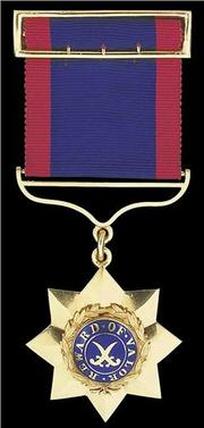 Indian Order of Merit (2nd Class).
Indian Order of Merit (2nd Class).
Jemadar Man Bahadur Gurung IOM. The untried junior officer walked slowly along the rail tracks, looking occasionally at the night sky above he wondered what adventures lay ahead for him during his time behind enemy lines in Burma. He did not have to wait long as within seconds the quiet Burmese evening was turned into a chaotic inferno, as a Japanese ambush engulfed the unsuspecting Chindits of Column 2.
Acting on instinct Man Bahadur dropped down into the gravel embankment and drew his rifle forward in front of him, he called out to his platoon to do the same. Unbeknown to the Chindit column, over 800 Japanese troops had made their way up to Kyaikthin village during the day and had lay in wait for them for the last few hours. Now the Japanese attacked the Gurkhas with everything they possessed and succeeded in cutting the column down into small and disjointed units of men.
A British officer called for dispersal and the signal was given, for those who could hear and understand the instruction it had not come a moment too soon and they melted away into the nearby scrubland and headed east. Column commander Major Emmett had pre-arranged a rendezvous a few miles further east, this was set out specifically for such events as an ambush, but the Japanese had surprised the young Gurkha unit and confusion got the better of them that night.
Jemadar Man Bahadur Gurung and some of his platoon had managed to hold their small position and this had allowed many of the muleteers and other personnel to withdraw into the jungle. He now called to his men to do the same.
Once they had moved a sensible distance away from the chaos of the embankment Man Bahadur took time to assess the condition of his platoon. He found that they had faired reasonably well considering the circumstances of the engagement. The platoon was still in good fighting order, although it had lost two of it's best Riflemen in the form of Man Bir Bura and Man Bahadur Tamang. These losses saddened the young Jemadar as he reflected on his own performance that night.
Here is how the senior commander of column 2, Major A. Emmett recounted Man Bahadur's performance on the 2nd March 1943, shown in the form of his recommendation citation for the Indian Order of Merit (2nd Class), which was awarded to the young Jemadar that year:
For I.O. 1132 Jemadar Man Bahadur Gurung of the 3/2 Gurkha Rilfes, the award of the I.O.M. (2nd Class).
At KYAIKTHIN on the night of 2/3 March 1943, the column to which this officer belonged was ambushed. During the resulting confusion he displayed great coolness and courage. After the main body succeeded in breaking off the engagement and extricating itself, this officer continued to occupy the position which he had taken up and to keep the enemy engaged. Although outnumbered he continued to fight and concentrated upon himself the attention of the greater part of the enemy, thus distracting them from pursuing other dispersal groups.
Next day he continued to lead his platoon eastwards in the hope of finding other parties. After a prolonged and unsuccessful search he lead his party safely back to the Chindwin carrying several automatic weapons, additional to his own, which he had found abandoned.
London Gazette 16/12/1943.
Lance Naik Jit Bahadur Rana IDSM was awarded his gallantry medal for his almost super-human effort to return to Allied territory after general dispersal was called in late March 1943. A member of Column 1 under the command of Major George Dunlop, the young Lance Corporal went through weeks of near starvation and hardship as he inched his way back toward the Assam border. Of all the columns that set out in February that year, Dunlop's unit went the furthest east into Burma, they were also the last group to turn around and head home.
For Column One every obstacle on that return journey cost somebody's life or liberty. The river crossings especially tested the strength and resolve of the men, with only the determined of mind and spirit overcoming each hurdle. Men withdrew into their deepest and sometimes darkest thoughts, focusing only on the next step forward in their desperate attempt for survival.
Here is Jit Bahadur's citation in full and seen in its original form, for some reason the recommendation was signed off by Mike Calvert the commander of Column 3, rather than Major Dunlop. Please click on the images to enlarge.
Acting on instinct Man Bahadur dropped down into the gravel embankment and drew his rifle forward in front of him, he called out to his platoon to do the same. Unbeknown to the Chindit column, over 800 Japanese troops had made their way up to Kyaikthin village during the day and had lay in wait for them for the last few hours. Now the Japanese attacked the Gurkhas with everything they possessed and succeeded in cutting the column down into small and disjointed units of men.
A British officer called for dispersal and the signal was given, for those who could hear and understand the instruction it had not come a moment too soon and they melted away into the nearby scrubland and headed east. Column commander Major Emmett had pre-arranged a rendezvous a few miles further east, this was set out specifically for such events as an ambush, but the Japanese had surprised the young Gurkha unit and confusion got the better of them that night.
Jemadar Man Bahadur Gurung and some of his platoon had managed to hold their small position and this had allowed many of the muleteers and other personnel to withdraw into the jungle. He now called to his men to do the same.
Once they had moved a sensible distance away from the chaos of the embankment Man Bahadur took time to assess the condition of his platoon. He found that they had faired reasonably well considering the circumstances of the engagement. The platoon was still in good fighting order, although it had lost two of it's best Riflemen in the form of Man Bir Bura and Man Bahadur Tamang. These losses saddened the young Jemadar as he reflected on his own performance that night.
Here is how the senior commander of column 2, Major A. Emmett recounted Man Bahadur's performance on the 2nd March 1943, shown in the form of his recommendation citation for the Indian Order of Merit (2nd Class), which was awarded to the young Jemadar that year:
For I.O. 1132 Jemadar Man Bahadur Gurung of the 3/2 Gurkha Rilfes, the award of the I.O.M. (2nd Class).
At KYAIKTHIN on the night of 2/3 March 1943, the column to which this officer belonged was ambushed. During the resulting confusion he displayed great coolness and courage. After the main body succeeded in breaking off the engagement and extricating itself, this officer continued to occupy the position which he had taken up and to keep the enemy engaged. Although outnumbered he continued to fight and concentrated upon himself the attention of the greater part of the enemy, thus distracting them from pursuing other dispersal groups.
Next day he continued to lead his platoon eastwards in the hope of finding other parties. After a prolonged and unsuccessful search he lead his party safely back to the Chindwin carrying several automatic weapons, additional to his own, which he had found abandoned.
London Gazette 16/12/1943.
Lance Naik Jit Bahadur Rana IDSM was awarded his gallantry medal for his almost super-human effort to return to Allied territory after general dispersal was called in late March 1943. A member of Column 1 under the command of Major George Dunlop, the young Lance Corporal went through weeks of near starvation and hardship as he inched his way back toward the Assam border. Of all the columns that set out in February that year, Dunlop's unit went the furthest east into Burma, they were also the last group to turn around and head home.
For Column One every obstacle on that return journey cost somebody's life or liberty. The river crossings especially tested the strength and resolve of the men, with only the determined of mind and spirit overcoming each hurdle. Men withdrew into their deepest and sometimes darkest thoughts, focusing only on the next step forward in their desperate attempt for survival.
Here is Jit Bahadur's citation in full and seen in its original form, for some reason the recommendation was signed off by Mike Calvert the commander of Column 3, rather than Major Dunlop. Please click on the images to enlarge.
Captain George William Noel Silcock.
"A first class Gurkha Rifles Company Commander." That is how RAF Liaison Officer, Robert Thompson described George Silcock in his own writings about Operation Longcloth, it is a view held by many others who were to work with this dependable and honourable soldier during those torrid months in the Burmese jungle.
The son of George Charles (a licensed victualler by trade) and Louisa Mary Silcock of Clarence Avenue, Kingston-upon-Thames, George Silcock was born on Christmas Day 1911and then attended Cranleigh School between the years 1924 and 1930. Set apart by his dark and bushy moustache, Captain Silcock was originally the senior officer in Column 3 and had led this unit through it's initial Chindit training in 1942. Harold James described him as: "Rather tubby and short, dark with a bristling moustache, which he constantly twirled and possessing a good sense of humour. Because Calvert could not speak Gurkhali, George had to translate orders. This was difficult for him as he did not always see eye to eye with the column commander, and yet he was always honest in his translations and in supporting Calvert.'
There is no doubt that George Silcock was extremely annoyed to have to hand over the command of his unit to Mike Calvert shortly before the men went into Burma, but he remained ever the professional soldier throughout the expedition, ensuring the men fully understood their orders and backing his new C/O to the hilt.
To Calvert's credit, he then allowed Silcock his area of influence within the column and together they achieved, arguably, the best results in regard to deployment of Gurkha Riflemen on Operation Longcloth. Calvert had spotted the Gurkhas dislike and misunderstanding of the dispersal tactic during their training period and he rarely used this system when the column was on active service in Burma. He realised that breaking the unit down into smaller groups when trouble or danger threatened, went totally against the Gurkhas instincts and deep sense of loyalty to what they saw as their extended family. It was at times like these that he took advice from George Silcock and between them they led the Gurkhas with efficiency and care.
In 2008 during my visit to Burma I was fortunate to meet Lieutenant Denis Gudgeon who was also a member of Column 3 on Operation Longcloth. Denis had worked closely with George Silcock whilst in Burma with the Chindits and described him along with Senior Gurkha Officer, Lieutenant-Colonel L.A. Alexander, as, "two of the most honourable and charming gentlemen I have ever met in Army uniform, always, always putting their Gurkhas first, foremost and above everything else".
There is no doubt that Silcock put the wellbeing of his Gurkhas first and foremost, whether that be ensuring they received their correct rations from the air supply drops in 1943, or, on one excruciatingly painful occasion, having to administer a lethal dose of morphine to a suffering and dying rifleman.
Captain Silcock led a section of 142 Commando, as they went about their demolitions at the rail station near Nankan village. He was also given command of one of Column 3's dispersal groups when orders finally came through to return to India. It was at this time that he once again teamed up with Denis Gudgeon. The two officers were given command of a platoon of Gurkhas each and turned westward for home. Silcock succeeded in getting his men back across the Chindwin River, but unfortunately, although his platoon did reach the safety of Assam, Denis himself fell at this final hurdle and was taken prisoner by the Japanese. Once again the compassionate Captain Silcock took the trouble to write to Denis's parents telling them of their son's recent fate and attempted to console them during those desperately worrying times.
After the Chindits had re-grouped back in India, the now Major Silcock was heavily involved in re-organisation of 3/2 Gurkha Rifles at Dehra Dun. Amongst the gallantry awards distributed to the men of Operation Longcloth came a 'Mention in Despatches' for George Silcock. Many of the men he had led and worked with on Operation Longcloth thought that his efforts should have been recognised by a far higher decoration.
Sadly, George Silcock did not survive the war in the Far East, he died on the 14th of January 1945 at a place called Akyab in the Arakan region of Burma. Lieutenant Harold James who was a young subaltern in Chindit Column 3 remembered the last time he saw Silcock in mid-1944:
"I bumped in to George at the Grand Hotel in Calcutta, one of the most famous meeting places for officers during the war. We found to our delight that we were both bound for Darjeeling and agreed to rendezvous at the hill station, where we were able to talk about old times. Then the following year he was tragically killed in an accident at Akyab. It was a sad end for such an excellent, brave officer and a good friend."
Denis Gudgeon added more detail about the accident, telling me that Major Silcock was billeted in a house on that fateful day, after his unit had re-taken an enemy position. Possibly due to fatigue or over-tiredness the Major, whilst still asleep, fell out of the upper window of the house and broke his back.
Major George Silcock was buried at Chittagong War Cemetery, now in present day Bangladesh. He is also remembered upon the Surbiton War Memorial in Surrey, close to where he and his family lived before the war. Seen below are photographs of the two memorials for George Silcock and his CWGC details.
http://www.cwgc.org/find-war-dead/casualty/2181102/SILCOCK,%20GEORGE%20WILLIAM%20NOEL
"A first class Gurkha Rifles Company Commander." That is how RAF Liaison Officer, Robert Thompson described George Silcock in his own writings about Operation Longcloth, it is a view held by many others who were to work with this dependable and honourable soldier during those torrid months in the Burmese jungle.
The son of George Charles (a licensed victualler by trade) and Louisa Mary Silcock of Clarence Avenue, Kingston-upon-Thames, George Silcock was born on Christmas Day 1911and then attended Cranleigh School between the years 1924 and 1930. Set apart by his dark and bushy moustache, Captain Silcock was originally the senior officer in Column 3 and had led this unit through it's initial Chindit training in 1942. Harold James described him as: "Rather tubby and short, dark with a bristling moustache, which he constantly twirled and possessing a good sense of humour. Because Calvert could not speak Gurkhali, George had to translate orders. This was difficult for him as he did not always see eye to eye with the column commander, and yet he was always honest in his translations and in supporting Calvert.'
There is no doubt that George Silcock was extremely annoyed to have to hand over the command of his unit to Mike Calvert shortly before the men went into Burma, but he remained ever the professional soldier throughout the expedition, ensuring the men fully understood their orders and backing his new C/O to the hilt.
To Calvert's credit, he then allowed Silcock his area of influence within the column and together they achieved, arguably, the best results in regard to deployment of Gurkha Riflemen on Operation Longcloth. Calvert had spotted the Gurkhas dislike and misunderstanding of the dispersal tactic during their training period and he rarely used this system when the column was on active service in Burma. He realised that breaking the unit down into smaller groups when trouble or danger threatened, went totally against the Gurkhas instincts and deep sense of loyalty to what they saw as their extended family. It was at times like these that he took advice from George Silcock and between them they led the Gurkhas with efficiency and care.
In 2008 during my visit to Burma I was fortunate to meet Lieutenant Denis Gudgeon who was also a member of Column 3 on Operation Longcloth. Denis had worked closely with George Silcock whilst in Burma with the Chindits and described him along with Senior Gurkha Officer, Lieutenant-Colonel L.A. Alexander, as, "two of the most honourable and charming gentlemen I have ever met in Army uniform, always, always putting their Gurkhas first, foremost and above everything else".
There is no doubt that Silcock put the wellbeing of his Gurkhas first and foremost, whether that be ensuring they received their correct rations from the air supply drops in 1943, or, on one excruciatingly painful occasion, having to administer a lethal dose of morphine to a suffering and dying rifleman.
Captain Silcock led a section of 142 Commando, as they went about their demolitions at the rail station near Nankan village. He was also given command of one of Column 3's dispersal groups when orders finally came through to return to India. It was at this time that he once again teamed up with Denis Gudgeon. The two officers were given command of a platoon of Gurkhas each and turned westward for home. Silcock succeeded in getting his men back across the Chindwin River, but unfortunately, although his platoon did reach the safety of Assam, Denis himself fell at this final hurdle and was taken prisoner by the Japanese. Once again the compassionate Captain Silcock took the trouble to write to Denis's parents telling them of their son's recent fate and attempted to console them during those desperately worrying times.
After the Chindits had re-grouped back in India, the now Major Silcock was heavily involved in re-organisation of 3/2 Gurkha Rifles at Dehra Dun. Amongst the gallantry awards distributed to the men of Operation Longcloth came a 'Mention in Despatches' for George Silcock. Many of the men he had led and worked with on Operation Longcloth thought that his efforts should have been recognised by a far higher decoration.
Sadly, George Silcock did not survive the war in the Far East, he died on the 14th of January 1945 at a place called Akyab in the Arakan region of Burma. Lieutenant Harold James who was a young subaltern in Chindit Column 3 remembered the last time he saw Silcock in mid-1944:
"I bumped in to George at the Grand Hotel in Calcutta, one of the most famous meeting places for officers during the war. We found to our delight that we were both bound for Darjeeling and agreed to rendezvous at the hill station, where we were able to talk about old times. Then the following year he was tragically killed in an accident at Akyab. It was a sad end for such an excellent, brave officer and a good friend."
Denis Gudgeon added more detail about the accident, telling me that Major Silcock was billeted in a house on that fateful day, after his unit had re-taken an enemy position. Possibly due to fatigue or over-tiredness the Major, whilst still asleep, fell out of the upper window of the house and broke his back.
Major George Silcock was buried at Chittagong War Cemetery, now in present day Bangladesh. He is also remembered upon the Surbiton War Memorial in Surrey, close to where he and his family lived before the war. Seen below are photographs of the two memorials for George Silcock and his CWGC details.
http://www.cwgc.org/find-war-dead/casualty/2181102/SILCOCK,%20GEORGE%20WILLIAM%20NOEL
Lieutenant Arthur Sidney Best.
Arthur was the son of Thomas and Elizabeth Best from Sompting in Sussex. He was born sometime in 1916 and in civilian life was a bank clerk and lived in the Balaam area of London. In 1943 Lieutenant Best found himself the Animal Transport Officer for Chindit Column 2 and in charge of the units Gurkha muleteers. Earlier in WW2 he had been fighting with the Territorial Army Battalion of the London Rifle Brigade and had served and survived the Allied reverse at Dunkirk, before joining the 9th Gurkhas in 1941.
Aged almost 30 by the time he served with the Chindits in Burma, Arthur Best was very much looked up to by many of the younger Gurkha subalterns, men such as Ian MacHorton, Alec Gibson and Denis Gudgeon. His experience and cool head had also resulted in Lieutenant Best being asked to perform other important duties during Chindit training, he was often asked for instance to sit on review panels and on at least one occasion a Court Martial hearing.
Here is how the young and inexperienced 2nd Lieutenant, Ian MacHorton remembered his friend from those times:
"In the hot stillness of our jungle hiding place I could at that moment afford to look with affection upon Arthur, and to contemplate my happy association with him since I had joined the Chindits. He had been my instructor, confessor, and continuous companion since I had joined the column.
Though he was a few years older than I, we had discovered many mutual interests. In fact, during many hours of jungle conversation our only serious difference of opinion had been over our respective views on the works of Mr. Ivor Novello and the value of the ballet as a medium for the expression of art. Differences hardly likely to cause a rift between us as we fought our way, often side by side, through the dense jungle to fulfil our task as decoys for Wingate's main striking force. So new a soldier myself, I regarded Arthur with all the respect that a recruit should give to a veteran.
A bank clerk in civil life, Arthur Best had been a rifleman in a crack Territorial Army Battalion of the London Rifle Brigade. He had known the ferocity and carnage of war and the heat of battle in the very early days. He had been one of those battered, bewildered, exhausted, outnumbered but indomitable British soldiers who had fought the rearguard action against the Germans all the way down to the beaches of Dunkirk.
Sometimes at night, before we rolled over to sleep deep in the whispering jungle, Arthur would paint for me lurid pictures of fighting against the Germans in France. I was proud that I, even though only a schoolboy of sixteen, had played my very small part in helping with the evacuation from those famous beaches.
My father had owned a 35ft. launch which was moored in Weymouth Harbour, and I had accompanied him on the high adventure of ferrying rescued soldiers back to Weymouth and Poole, from Dover, Beachy Head, and other places where they had been put down by the little ships shuttling valiantly backwards and forwards between England and France.
To be serving now with a man who had been through the real thing was quite something. After his showing in France and at Dunkirk, Arthur Best was put forward as the right material for an officer, and was eventually commissioned into the 9th Gurkha Rifles, during 1941. He had found his work tedious at his Regimental Centre and had volunteered for "special duty" with the 77th Independent Infantry Brigade. It was only natural that, by virtue of the fact that he was a keen amateur mechanic, he should immediately have been appointed Animal Transport Officer in charge of No. 2 Column's mules when he joined the Wingate force.
All through those days now behind us, of fighting our way through bitter jungle always beneath the unrelenting blaze of the Burmese sun, Arthur had been a strong and staunch companion. He had been a stout friend to whom I could look for help and advice whenever I needed it. And now, on what was likely to be the eve of my first battle, I was more glad than ever to have him beside me."
That first battle was to come sooner than 2nd Lieutenant MacHorton might have imagined. On the 2nd of March 1943 at the railway town of Kyaikthin Chindit Column 2 were ambushed by a large Japanese force and a ferocious battle took place. Column 2 fared worse and in the carnage that night Arthur Best was fortunate indeed to lead most of his Gurkhas and their mules away from the battle field and into the nearby scrub jungle.
The next morning he met up with the Column's RAF Liaison Officer, Flight Lieutenant John Kingsley Edmonds and under his charge moved off towards the formerly agreed rendezvous point close to the western banks of the Irrawaddy River. This small group met Chindit Column 1 along the way and became part of this unit led by Major George Dunlop of the Royal Scots. Arthur Best remained with Dunlop's group for the next six weeks and was with the Major when dispersal was called and the men turned round and began the long and arduous march back to India.
It was on this return journey that things began to go wrong for the beleaguered Chindits. They struggled to find enough food and water when entering the villages they passed through and the many Burmese rivers, both large and small, proved at times almost insurmountable obstacles for the weary men. On the 2nd May, the Column were searching for food in a small village near the River Mu when they were attacked by a Japanese patrol. Enemy machine gun fire raked through the line of unsuspecting Chindits, killing many and wounding a great deal more.
Once again, I will allow Ian Machorton to describe that hellish moment:
"Slowly and methodically men everywhere got to their feet. They began to wriggle into their equipment and take anew the strain of their packs. Arthur Best was to be the advance guard for what was left of the column and with a lighthearted wave turned and was gone. Gone forever-gone amidst the sudden vicious hail of bullets which tore into us at that moment from the Jap fighting patrol who had sneaked up on us through the jungle. Gone, I was to learn years later, to be murdered as a prisoner of war by the bayonets of the brutal little Jap animals that had been sent to guard him."
Seen below are images of Arthur Best and his young Chindit comrade 2nd Lieutenant Ian MacHorton. Please click on either image to bring it forward on the page.
Arthur was the son of Thomas and Elizabeth Best from Sompting in Sussex. He was born sometime in 1916 and in civilian life was a bank clerk and lived in the Balaam area of London. In 1943 Lieutenant Best found himself the Animal Transport Officer for Chindit Column 2 and in charge of the units Gurkha muleteers. Earlier in WW2 he had been fighting with the Territorial Army Battalion of the London Rifle Brigade and had served and survived the Allied reverse at Dunkirk, before joining the 9th Gurkhas in 1941.
Aged almost 30 by the time he served with the Chindits in Burma, Arthur Best was very much looked up to by many of the younger Gurkha subalterns, men such as Ian MacHorton, Alec Gibson and Denis Gudgeon. His experience and cool head had also resulted in Lieutenant Best being asked to perform other important duties during Chindit training, he was often asked for instance to sit on review panels and on at least one occasion a Court Martial hearing.
Here is how the young and inexperienced 2nd Lieutenant, Ian MacHorton remembered his friend from those times:
"In the hot stillness of our jungle hiding place I could at that moment afford to look with affection upon Arthur, and to contemplate my happy association with him since I had joined the Chindits. He had been my instructor, confessor, and continuous companion since I had joined the column.
Though he was a few years older than I, we had discovered many mutual interests. In fact, during many hours of jungle conversation our only serious difference of opinion had been over our respective views on the works of Mr. Ivor Novello and the value of the ballet as a medium for the expression of art. Differences hardly likely to cause a rift between us as we fought our way, often side by side, through the dense jungle to fulfil our task as decoys for Wingate's main striking force. So new a soldier myself, I regarded Arthur with all the respect that a recruit should give to a veteran.
A bank clerk in civil life, Arthur Best had been a rifleman in a crack Territorial Army Battalion of the London Rifle Brigade. He had known the ferocity and carnage of war and the heat of battle in the very early days. He had been one of those battered, bewildered, exhausted, outnumbered but indomitable British soldiers who had fought the rearguard action against the Germans all the way down to the beaches of Dunkirk.
Sometimes at night, before we rolled over to sleep deep in the whispering jungle, Arthur would paint for me lurid pictures of fighting against the Germans in France. I was proud that I, even though only a schoolboy of sixteen, had played my very small part in helping with the evacuation from those famous beaches.
My father had owned a 35ft. launch which was moored in Weymouth Harbour, and I had accompanied him on the high adventure of ferrying rescued soldiers back to Weymouth and Poole, from Dover, Beachy Head, and other places where they had been put down by the little ships shuttling valiantly backwards and forwards between England and France.
To be serving now with a man who had been through the real thing was quite something. After his showing in France and at Dunkirk, Arthur Best was put forward as the right material for an officer, and was eventually commissioned into the 9th Gurkha Rifles, during 1941. He had found his work tedious at his Regimental Centre and had volunteered for "special duty" with the 77th Independent Infantry Brigade. It was only natural that, by virtue of the fact that he was a keen amateur mechanic, he should immediately have been appointed Animal Transport Officer in charge of No. 2 Column's mules when he joined the Wingate force.
All through those days now behind us, of fighting our way through bitter jungle always beneath the unrelenting blaze of the Burmese sun, Arthur had been a strong and staunch companion. He had been a stout friend to whom I could look for help and advice whenever I needed it. And now, on what was likely to be the eve of my first battle, I was more glad than ever to have him beside me."
That first battle was to come sooner than 2nd Lieutenant MacHorton might have imagined. On the 2nd of March 1943 at the railway town of Kyaikthin Chindit Column 2 were ambushed by a large Japanese force and a ferocious battle took place. Column 2 fared worse and in the carnage that night Arthur Best was fortunate indeed to lead most of his Gurkhas and their mules away from the battle field and into the nearby scrub jungle.
The next morning he met up with the Column's RAF Liaison Officer, Flight Lieutenant John Kingsley Edmonds and under his charge moved off towards the formerly agreed rendezvous point close to the western banks of the Irrawaddy River. This small group met Chindit Column 1 along the way and became part of this unit led by Major George Dunlop of the Royal Scots. Arthur Best remained with Dunlop's group for the next six weeks and was with the Major when dispersal was called and the men turned round and began the long and arduous march back to India.
It was on this return journey that things began to go wrong for the beleaguered Chindits. They struggled to find enough food and water when entering the villages they passed through and the many Burmese rivers, both large and small, proved at times almost insurmountable obstacles for the weary men. On the 2nd May, the Column were searching for food in a small village near the River Mu when they were attacked by a Japanese patrol. Enemy machine gun fire raked through the line of unsuspecting Chindits, killing many and wounding a great deal more.
Once again, I will allow Ian Machorton to describe that hellish moment:
"Slowly and methodically men everywhere got to their feet. They began to wriggle into their equipment and take anew the strain of their packs. Arthur Best was to be the advance guard for what was left of the column and with a lighthearted wave turned and was gone. Gone forever-gone amidst the sudden vicious hail of bullets which tore into us at that moment from the Jap fighting patrol who had sneaked up on us through the jungle. Gone, I was to learn years later, to be murdered as a prisoner of war by the bayonets of the brutal little Jap animals that had been sent to guard him."
Seen below are images of Arthur Best and his young Chindit comrade 2nd Lieutenant Ian MacHorton. Please click on either image to bring it forward on the page.
Ian MacHorton had understandably feared the worst for his friend after the attack near the River Mu, but, as he later found out, Arthur Best had in fact survived the engagement and been taken prisoner by the Japanese. On his POW records it states the 2nd of May 1943 as his date of capture.
Lieutenant Best was to spend nearly two years in Rangoon Jail, sharing a large and uncomfortable cell with the other captured Chindit Officers; men such as Denis Gudgeon, Alec Gibson and Flight Lieutenant John Edmonds. He was given the POW number 37 and had to learn how to recite this number in Japanese for the morning and evening roll calls known as 'tenkos'.
In late April 1945 the Japanese guards selected 400 or so of the fittest prisoners and marched them out of Rangoon Jail. The idea was to take these men across the border and into Thailand, probably to work on the northern section of infamous Burma Railway. Within a few short days the Japanese realised that this had been a mistake and set the prisoners free close to a village called Waw near Pegu.
Sadly, Arthur Best did not enjoy the euphoria of being liberated that day. He had struggled to keep up with the line of march from the outset and suffering badly from exhaustion and fatigue, continually dropped down by the roadside to take a rest. The Japanese guards had repeatedly warned the prisoners that any man who dropped out of line and could no longer march would be dealt with in the severest manner. Arthur's Chindit pals, including Denis Gudgeon, had supported their comrade for as long as their own weary bodies would allow. Finally and in exasperation, they urged their friend to make one last effort to continue marching. Arthur waved them away, repeating that he simply needed a short rest and would catch them up at the next halt. They never saw him again.
In 2008 whilst on tour in Burma, Denis Gudgeon informed me that the Japanese guards had bayonetted Lieutenant Best where he lay and left him to die on the roadside. Denis was still clearly upset when recalling that terrible moment from April 1945. Here is a very short piece from my audio recordings with Denis, where he remembers the last conversation he had with Arthur Best.
Lieutenant Best was to spend nearly two years in Rangoon Jail, sharing a large and uncomfortable cell with the other captured Chindit Officers; men such as Denis Gudgeon, Alec Gibson and Flight Lieutenant John Edmonds. He was given the POW number 37 and had to learn how to recite this number in Japanese for the morning and evening roll calls known as 'tenkos'.
In late April 1945 the Japanese guards selected 400 or so of the fittest prisoners and marched them out of Rangoon Jail. The idea was to take these men across the border and into Thailand, probably to work on the northern section of infamous Burma Railway. Within a few short days the Japanese realised that this had been a mistake and set the prisoners free close to a village called Waw near Pegu.
Sadly, Arthur Best did not enjoy the euphoria of being liberated that day. He had struggled to keep up with the line of march from the outset and suffering badly from exhaustion and fatigue, continually dropped down by the roadside to take a rest. The Japanese guards had repeatedly warned the prisoners that any man who dropped out of line and could no longer march would be dealt with in the severest manner. Arthur's Chindit pals, including Denis Gudgeon, had supported their comrade for as long as their own weary bodies would allow. Finally and in exasperation, they urged their friend to make one last effort to continue marching. Arthur waved them away, repeating that he simply needed a short rest and would catch them up at the next halt. They never saw him again.
In 2008 whilst on tour in Burma, Denis Gudgeon informed me that the Japanese guards had bayonetted Lieutenant Best where he lay and left him to die on the roadside. Denis was still clearly upset when recalling that terrible moment from April 1945. Here is a very short piece from my audio recordings with Denis, where he remembers the last conversation he had with Arthur Best.
Arthur Best was killed by the Japanese on the 28th April 1943, just a few short hours before the other POW's were given their freedom. His body was never recovered, and so, unlike the other men who perished whilst prisoners of war in Rangoon, he is remembered upon the Rangoon Memorial and not in Rangoon War Cemetery. Here are his CWGC details:
http://www.cwgc.org/find-war-dead/casualty/2505162/BEST,%20ARTHUR%20SIDNEY
Seen below are some images that illustrate the story of Arthur Best and his sad demise in April 1945. Please click on any image to bring it forward on the page. To finish this story, I will share Denis Gudgeon's thoughts about Lieutenant Arthur Sidney Best from our conversations in Burma in March 2008.
http://www.cwgc.org/find-war-dead/casualty/2505162/BEST,%20ARTHUR%20SIDNEY
Seen below are some images that illustrate the story of Arthur Best and his sad demise in April 1945. Please click on any image to bring it forward on the page. To finish this story, I will share Denis Gudgeon's thoughts about Lieutenant Arthur Sidney Best from our conversations in Burma in March 2008.
"Arthur was a good soldier and Gurkha officer, there is no doubt; but more importantly he was a very good friend."
Update 17/10/2019.
Another account of what happened to Arthur Best on the march out from Rangoon has come to light in a book entitled: Pilot, Prisoner, Survivor, written by Harvey Besley a former pilot with the Royal Australian Air Force and erstwhile POW inside Rangoon Jail.
Besley recalled:
By the second night of the march the men were all hungry and suffering with their feet. To say the least it was a bleak outlook, but the third night was far worse. Allied planes were coming over constantly and we had to duck for cover whenever we heard them. The guards had become bad tempered and had begun to hit and push us around and generally make life hell for us. We were sick to the teeth of them and the whole show. They seemed to have to take their frustrations out on us whenever things went wrong. Several of the men dropped out; they could no longer take the marching.
One of the first to drop out was Lieutenant Best. He had been in bad health and weak back in the gaol. He should never have been allowed to come in the first place. But being an officer, he was left to decide for himself, and naturally he came along. It was thought at the time, that anyone left at the gaol would be shot as soon as the others left. Naturally, anyone who was at all able to walk, wanted to leave. As things turned out, it was the other way around. Those who stayed behind got the best of the deal, but we were not to know that at the time.
When a prisoner dropped out, a guard was left behind with him. We felt pretty sure that the guard either shot or bayonetted the prisoner as soon as we got out of hearing. It was fairly conclusive, as the guard would catch up to us within half an hour and tell us that the prisoner had been left with some natives. Three of our number suffered this fate. On one occasion, one of my group an Australian named Peter Wilson collapsed, but being with a cart we were able to go on by getting him onto the cart and giving him a rest. He was then able to manage under his own steam after this, but I've no doubt that the ride on the cart saved his life. At this stage, the men were in a desperate state and it was only the knowledge of what would happen if they dropped out which drove them on.
Another account of what happened to Arthur Best on the march out from Rangoon has come to light in a book entitled: Pilot, Prisoner, Survivor, written by Harvey Besley a former pilot with the Royal Australian Air Force and erstwhile POW inside Rangoon Jail.
Besley recalled:
By the second night of the march the men were all hungry and suffering with their feet. To say the least it was a bleak outlook, but the third night was far worse. Allied planes were coming over constantly and we had to duck for cover whenever we heard them. The guards had become bad tempered and had begun to hit and push us around and generally make life hell for us. We were sick to the teeth of them and the whole show. They seemed to have to take their frustrations out on us whenever things went wrong. Several of the men dropped out; they could no longer take the marching.
One of the first to drop out was Lieutenant Best. He had been in bad health and weak back in the gaol. He should never have been allowed to come in the first place. But being an officer, he was left to decide for himself, and naturally he came along. It was thought at the time, that anyone left at the gaol would be shot as soon as the others left. Naturally, anyone who was at all able to walk, wanted to leave. As things turned out, it was the other way around. Those who stayed behind got the best of the deal, but we were not to know that at the time.
When a prisoner dropped out, a guard was left behind with him. We felt pretty sure that the guard either shot or bayonetted the prisoner as soon as we got out of hearing. It was fairly conclusive, as the guard would catch up to us within half an hour and tell us that the prisoner had been left with some natives. Three of our number suffered this fate. On one occasion, one of my group an Australian named Peter Wilson collapsed, but being with a cart we were able to go on by getting him onto the cart and giving him a rest. He was then able to manage under his own steam after this, but I've no doubt that the ride on the cart saved his life. At this stage, the men were in a desperate state and it was only the knowledge of what would happen if they dropped out which drove them on.
Rifleman Janga Bahadur Thaman. This soldier was originally serving with the 10th Gurkha Regiment before he was drafted into the 77th Indian Infantry Brigade as a mule driver in late 1942. It is not known which Chindit Column Janga belonged to on Operation Longcloth, but we do know that he became a prisoner of war in 1943.
The Japanese tended to keep captured Gurkha Riflemen working for them in the field, rather than sending them on to large camps such Maymyo or Rangoon Jail. Often they were used as muleteers by their captors, transporting supplies up to the front line, especially during the battles of Imphal and Kohima. So, quite often the captured Gurkhas found themselves working close to the Assam border at places like Kalaw on the eastern banks of the Chindwin River. Many used this opportunity to break for freedom and escape back to Allied held territory.
We know that Janga Bahadur Thaman was a POW because he was recovered by Chindit Column 65, part of the 14th British Infantry Brigade in July 1944 during the second Chindit operation. After giving information at his debrief interview, Janga was cleared of any collusion with the enemy and returned to the Regimental Centre for the 10th Gurkha Rifles where he re-joined his original unit.
Seen below is a copy of the war diary entry recording his liberation by Column 65 on the 16th July 1944.
The Japanese tended to keep captured Gurkha Riflemen working for them in the field, rather than sending them on to large camps such Maymyo or Rangoon Jail. Often they were used as muleteers by their captors, transporting supplies up to the front line, especially during the battles of Imphal and Kohima. So, quite often the captured Gurkhas found themselves working close to the Assam border at places like Kalaw on the eastern banks of the Chindwin River. Many used this opportunity to break for freedom and escape back to Allied held territory.
We know that Janga Bahadur Thaman was a POW because he was recovered by Chindit Column 65, part of the 14th British Infantry Brigade in July 1944 during the second Chindit operation. After giving information at his debrief interview, Janga was cleared of any collusion with the enemy and returned to the Regimental Centre for the 10th Gurkha Rifles where he re-joined his original unit.
Seen below is a copy of the war diary entry recording his liberation by Column 65 on the 16th July 1944.
Captain Hubert R. Birtwhistle. Hubert Birtwhistle was the Adjutant for Southern Group in 1942/43. It was his task to collate all the new personnel recently posted to the 3/2 Gurkha Rifles in preparation for Operation Longcloth and to allocate them to a Chindit Column. It seems that for all the young officers attached to 3/2 Gurkha in the last few weeks of 1942 and early 1943, Hubert came over as a 'larger than life' sort of character, possessing a dry, sardonic sense of humour.
After the operation was closed in mid-1943 he was also given the job of reorganising the battalion at their base in Dehra Dun. As the exhausted Gurkhas returned in small penny-packets from their exertions in Burma, Hubert also compiled the casualty and missing in action listings for the battalion, which must have been an unenviable and heart-breaking duty to perform.
Two of the young Gurkha subalterns who served on Operation Longcloth, Ian MacHorton and Harold James, both described their first meeting with Captain Birtwhistle in their respective books, 'Safer than a Known Way' and 'Across the Threshold of Battle'.
MacHorton remembered:
"The story had started for me at Jhansi, a cantonment in Indian jungle country where the Chindits had done most of their training. In the sweltering heat of the afternoon I arrived and I sensed at once the atmosphere was electric. Newly commissioned, I was joining them on the very eve of entraining for Dimapur, on the Assam-Burma border, from where the great march eastwards was to start.
Captain Birtwhistle from 3/2 Gurkha Rifles and Adjutant of No. 1 Group, was sitting at a blanket-covered trestle table in the 180-pounder tent which served as the orderly room for the battalion. I stamped in smartly to announce my arrival and the interior of the tent engulfed me in heat, like an oven.
Sweat was coursing down the Adjutant's face as he looked up sharply. It ran in rivulets down his chest, and dripped steadily from his armpits. Sweating just as liberally, I stood at ease before him, and watched him pick up his fountain pen and dry his fingers on the blanket table cover before attempting to write my name in capital letters on the pro-forma before him.
As he wrote the date, January 7th, 1943, sweat from his brow dropped on the paper and smudged the ink, so that he had to dab it with a corner of the blanket and write anew beside the smudging. "Rank, 2nd Lieutenant," he mumbled, seemingly to himself, as he began to fill in the details. "Regiment, 8th Gurkhas." He looked up: "Date of present commission?"
"The fourth of October, sir, 1942," I replied.
"Age?"
"Nineteen."
"Next of kin?"
"Father, sir."
And so, in between pauses to mop sweat from his brow and chest with a sodden handkerchief, and to blot it from the paper in a hopeless attempt to keep the pro-forma neat, he filled in all my particulars. "Right. Now you are to join No. 2 Column," he said tersely. "Major Emmett is in command. You had better report straight away, there is not a lot of time."
I took one pace to the rear and saluted. The great adventure had started."
Lieutenant Harold James, who was to be awarded a Military Cross for his efforts on Operation Longcloth was with Ian MacHorton that day; he remembered the same meeting thus:
"I was one of the several junior officers from other Gurkha and British Regiments transferred to the Brigade at almost the last hour. Only a few months earlier I had been commissioned into the 8th Gurkha Rifles and posted to the Regimental Centre at Quetta in Northern India with my friend, Ian MacHorton. Shortly afterwards we were joined by Alec Mackay Gibson.
A week or so after Christmas mysterious orders were received posting the three of us to an unspecified formation in Jhansi. Everyone in the Regimental Centre was foxed, and as it appeared to be a permanent posting we took, as was the custom in those days, all our gear in steel trunks, the usual portable gramophone and our Indian bearers.
After the traditional long, complicated train journey, with several changes, and hours spent on deserted platforms, we reached Jhansi, and were transported to a vast camp. Arriving in the darkness, we were taken immediately to the Adjutant of the 3/2nd Gurkha Rifles.
As we stood in his tent, Birty Birtwhistle asked, 'Do you know why you are here?' We confessed our ignorance, and with a knowing smile he said, 'You're going into Burma in a few days, time.' Then added, 'I suppose you have made out your wills?' This sent a tremor of apprehension down our spines."
In 1944 the battalion were sent to the Arakan region of Burma, where they engaged the Japanese once again, this time as part of the 25th Indian Division. Hubert Birtwhistle, by this time a Major was in charge of the Head Quarters Company. Seen below is a photograph of Hubert from his time in the Arakan in 1944, it was taken during the monsoon season, somewhere along the Maungdaw/Buthidaung line. The fighting in the Arakan was often hand to hand and control of the swampy wetlands and razor-backed hills in this region was fiercely contested by the Japanese.
After the operation was closed in mid-1943 he was also given the job of reorganising the battalion at their base in Dehra Dun. As the exhausted Gurkhas returned in small penny-packets from their exertions in Burma, Hubert also compiled the casualty and missing in action listings for the battalion, which must have been an unenviable and heart-breaking duty to perform.
Two of the young Gurkha subalterns who served on Operation Longcloth, Ian MacHorton and Harold James, both described their first meeting with Captain Birtwhistle in their respective books, 'Safer than a Known Way' and 'Across the Threshold of Battle'.
MacHorton remembered:
"The story had started for me at Jhansi, a cantonment in Indian jungle country where the Chindits had done most of their training. In the sweltering heat of the afternoon I arrived and I sensed at once the atmosphere was electric. Newly commissioned, I was joining them on the very eve of entraining for Dimapur, on the Assam-Burma border, from where the great march eastwards was to start.
Captain Birtwhistle from 3/2 Gurkha Rifles and Adjutant of No. 1 Group, was sitting at a blanket-covered trestle table in the 180-pounder tent which served as the orderly room for the battalion. I stamped in smartly to announce my arrival and the interior of the tent engulfed me in heat, like an oven.
Sweat was coursing down the Adjutant's face as he looked up sharply. It ran in rivulets down his chest, and dripped steadily from his armpits. Sweating just as liberally, I stood at ease before him, and watched him pick up his fountain pen and dry his fingers on the blanket table cover before attempting to write my name in capital letters on the pro-forma before him.
As he wrote the date, January 7th, 1943, sweat from his brow dropped on the paper and smudged the ink, so that he had to dab it with a corner of the blanket and write anew beside the smudging. "Rank, 2nd Lieutenant," he mumbled, seemingly to himself, as he began to fill in the details. "Regiment, 8th Gurkhas." He looked up: "Date of present commission?"
"The fourth of October, sir, 1942," I replied.
"Age?"
"Nineteen."
"Next of kin?"
"Father, sir."
And so, in between pauses to mop sweat from his brow and chest with a sodden handkerchief, and to blot it from the paper in a hopeless attempt to keep the pro-forma neat, he filled in all my particulars. "Right. Now you are to join No. 2 Column," he said tersely. "Major Emmett is in command. You had better report straight away, there is not a lot of time."
I took one pace to the rear and saluted. The great adventure had started."
Lieutenant Harold James, who was to be awarded a Military Cross for his efforts on Operation Longcloth was with Ian MacHorton that day; he remembered the same meeting thus:
"I was one of the several junior officers from other Gurkha and British Regiments transferred to the Brigade at almost the last hour. Only a few months earlier I had been commissioned into the 8th Gurkha Rifles and posted to the Regimental Centre at Quetta in Northern India with my friend, Ian MacHorton. Shortly afterwards we were joined by Alec Mackay Gibson.
A week or so after Christmas mysterious orders were received posting the three of us to an unspecified formation in Jhansi. Everyone in the Regimental Centre was foxed, and as it appeared to be a permanent posting we took, as was the custom in those days, all our gear in steel trunks, the usual portable gramophone and our Indian bearers.
After the traditional long, complicated train journey, with several changes, and hours spent on deserted platforms, we reached Jhansi, and were transported to a vast camp. Arriving in the darkness, we were taken immediately to the Adjutant of the 3/2nd Gurkha Rifles.
As we stood in his tent, Birty Birtwhistle asked, 'Do you know why you are here?' We confessed our ignorance, and with a knowing smile he said, 'You're going into Burma in a few days, time.' Then added, 'I suppose you have made out your wills?' This sent a tremor of apprehension down our spines."
In 1944 the battalion were sent to the Arakan region of Burma, where they engaged the Japanese once again, this time as part of the 25th Indian Division. Hubert Birtwhistle, by this time a Major was in charge of the Head Quarters Company. Seen below is a photograph of Hubert from his time in the Arakan in 1944, it was taken during the monsoon season, somewhere along the Maungdaw/Buthidaung line. The fighting in the Arakan was often hand to hand and control of the swampy wetlands and razor-backed hills in this region was fiercely contested by the Japanese.
Havildar Ran Sing Gurung IDSM
Action for which recommended:
Operations in Burma, March/April 1943.
On 3rd March, 1943, the column to which this N.C.O. belonged was ambushed near KYAIKTHIN. He was one was a small party which, with a British Officer, joined up with a platoon of Burma Riflemen and set out on a prolonged march across the IRRAWADDY and through the KACHIN Hills. Throughout the period he proved himself an admirable N.C.O. of great courage and resource, and was of the utmost assistance to his commander.
IDSM Recommended By:
Lt. J.E.Stephenson (Column 2)
3/2nd Gurkha Rifles
77th Indian Infantry Brigade
Action for which recommended:
Operations in Burma, March/April 1943.
On 3rd March, 1943, the column to which this N.C.O. belonged was ambushed near KYAIKTHIN. He was one was a small party which, with a British Officer, joined up with a platoon of Burma Riflemen and set out on a prolonged march across the IRRAWADDY and through the KACHIN Hills. Throughout the period he proved himself an admirable N.C.O. of great courage and resource, and was of the utmost assistance to his commander.
IDSM Recommended By:
Lt. J.E.Stephenson (Column 2)
3/2nd Gurkha Rifles
77th Indian Infantry Brigade
Rifleman Gamane Rai. POW witness statement for Rfm. 107517 Gamane Rai.
The above soldier was reported missing, date unknown, from the first Wingate expedition in 1943. He re-joined the Regimental Centre for the 2nd Gurkha Rifles on 21/11/1944 after release from 44. I.C.D on 16th November.
Here is his statement:
I went into Burma with No. 5 Column in January 1943. The commander of my section was Jemadar Harkaman Tamang. After crossing the Irrawaddy River, we went up to the Shweli River. On arrival here we came to know of an enemy force of large numbers, so we received orders to retire from the area.
After marching some days in the jungle we arrived once again at the banks of the Irrawaddy where we found two boats and some Burmese to ferry us across. They took us to the other end of the river where there were two streams. We crossed the first stream, but were left on some sand, the Burmese men ran away with the boats without helping us across the second stream, so we had to spend the night on the sand.
NB. I believe that Rfm. Gamane Rai has confused his rivers in his account, as he has very accurately described the incident on 1st April 1943, when 40 plus men from Column 5 found themselves stranded on a large sandbank in the middle of the Shweli River.
Gamane Rai continues;
The next day at about 4am. the Japanese opened fire on us making some casualties. Then one of the British Other Ranks hanged a white napkin on his rifle and raised it in the sky, then they ceased firing. They came to us and withdrew all our weapons and other equipment. Then they took us to the other end of the river. We had our hands tied for one week while we remained at a village near the river.
Our group was made up of about 20 B.O.R.'s and 17 Gurkhas. We were eventually taken to Bhamo Jail where we remained for sometime. After staying there they detailed us as mule drivers, giving us animals to look after.
NB. From other similar witness statements made by Gurkha Riflemen, I believe that the British POW's were not asked to perform mule driving duties, the Japanese seem to only hand out such work to the Indian captives.
Gamane continues:
We then moved on to Maymyo Jail, after a short while the Japanese sent the British men off to Rangoon. From our number (17) they selected 12 men, including myself and sent us to Katha Camp. On arrival, myself and two others were assigned 'mule grooming' duties, while the others were given other more general tasks. We remained at Katha for one and a half years, mostly carrying rations to one place or another.
One day a Japanese soldier showed me the path from where out troops were expected to be coming, I kept this in my mind and to one day use it to escape. Then on a day when I was detailed to bring water and fodder for the mules I set out to escape from the camp and moved away into the jungle.
After spending a night in the jungle I reached a Gurkha 'busty' (not sure why this refers to), this was two miles from a Japanese Camp I had been held at before. The villagers gave me shelter in their houses at night, during the day I would conceal myself in the jungle. I stayed here for 12 days.
Eventually I was taken to Allied lines about four miles from the village that had kept me safe. I was handed over to Indian troops who arranged for me to be taken back to India. I was not feeling well and was flown out to Panitola Hospital. I eventually ended up at 44 I.C.D. from where I returned to Dehra Dun and my Regimental Centre.
During my captivity with the Japanese they gave me 15-20 rupees per month, but whatever I received was forcibly taken from me by the Japanese guards. I am unable to tell the names of the other Gurkhas who were with me, as they came to the 3rd Battalion from other regiments.
NB. These men were almost certainly from the 10th Gurkha Rifles who provided a large draft of men to act as muleteers in the various Chindit Columns in 1943.
Gamane Rai ends his testimony there, with his mark in lieu of a signature. He was then released with the category 'white', this meant that he had satisfied the interrogation panel that he had not assisted or colluded with the Japanese in anyway. He was then able to re-join his unit and continue his service without restriction.
Below are two maps illustrating the story of Gamane Rai. Firstly, a map showing the River Shweli and the sandbank where the men from Column 5 were left stranded and from which location they became prisoners of war. Secondly, a map of the area around the Burmese town of Katha which was an important transport link for the Japanese in 1944 providing both rail and river transport opportunities. Please click on each image to bring them forward on the page.
The above soldier was reported missing, date unknown, from the first Wingate expedition in 1943. He re-joined the Regimental Centre for the 2nd Gurkha Rifles on 21/11/1944 after release from 44. I.C.D on 16th November.
Here is his statement:
I went into Burma with No. 5 Column in January 1943. The commander of my section was Jemadar Harkaman Tamang. After crossing the Irrawaddy River, we went up to the Shweli River. On arrival here we came to know of an enemy force of large numbers, so we received orders to retire from the area.
After marching some days in the jungle we arrived once again at the banks of the Irrawaddy where we found two boats and some Burmese to ferry us across. They took us to the other end of the river where there were two streams. We crossed the first stream, but were left on some sand, the Burmese men ran away with the boats without helping us across the second stream, so we had to spend the night on the sand.
NB. I believe that Rfm. Gamane Rai has confused his rivers in his account, as he has very accurately described the incident on 1st April 1943, when 40 plus men from Column 5 found themselves stranded on a large sandbank in the middle of the Shweli River.
Gamane Rai continues;
The next day at about 4am. the Japanese opened fire on us making some casualties. Then one of the British Other Ranks hanged a white napkin on his rifle and raised it in the sky, then they ceased firing. They came to us and withdrew all our weapons and other equipment. Then they took us to the other end of the river. We had our hands tied for one week while we remained at a village near the river.
Our group was made up of about 20 B.O.R.'s and 17 Gurkhas. We were eventually taken to Bhamo Jail where we remained for sometime. After staying there they detailed us as mule drivers, giving us animals to look after.
NB. From other similar witness statements made by Gurkha Riflemen, I believe that the British POW's were not asked to perform mule driving duties, the Japanese seem to only hand out such work to the Indian captives.
Gamane continues:
We then moved on to Maymyo Jail, after a short while the Japanese sent the British men off to Rangoon. From our number (17) they selected 12 men, including myself and sent us to Katha Camp. On arrival, myself and two others were assigned 'mule grooming' duties, while the others were given other more general tasks. We remained at Katha for one and a half years, mostly carrying rations to one place or another.
One day a Japanese soldier showed me the path from where out troops were expected to be coming, I kept this in my mind and to one day use it to escape. Then on a day when I was detailed to bring water and fodder for the mules I set out to escape from the camp and moved away into the jungle.
After spending a night in the jungle I reached a Gurkha 'busty' (not sure why this refers to), this was two miles from a Japanese Camp I had been held at before. The villagers gave me shelter in their houses at night, during the day I would conceal myself in the jungle. I stayed here for 12 days.
Eventually I was taken to Allied lines about four miles from the village that had kept me safe. I was handed over to Indian troops who arranged for me to be taken back to India. I was not feeling well and was flown out to Panitola Hospital. I eventually ended up at 44 I.C.D. from where I returned to Dehra Dun and my Regimental Centre.
During my captivity with the Japanese they gave me 15-20 rupees per month, but whatever I received was forcibly taken from me by the Japanese guards. I am unable to tell the names of the other Gurkhas who were with me, as they came to the 3rd Battalion from other regiments.
NB. These men were almost certainly from the 10th Gurkha Rifles who provided a large draft of men to act as muleteers in the various Chindit Columns in 1943.
Gamane Rai ends his testimony there, with his mark in lieu of a signature. He was then released with the category 'white', this meant that he had satisfied the interrogation panel that he had not assisted or colluded with the Japanese in anyway. He was then able to re-join his unit and continue his service without restriction.
Below are two maps illustrating the story of Gamane Rai. Firstly, a map showing the River Shweli and the sandbank where the men from Column 5 were left stranded and from which location they became prisoners of war. Secondly, a map of the area around the Burmese town of Katha which was an important transport link for the Japanese in 1944 providing both rail and river transport opportunities. Please click on each image to bring them forward on the page.
Captain James 'Jimmy' Smallwood. James Smallwood is one of the lesser known men from 3/2 Gurkha Rifles in regards to his service with the battalion in 1942-43 and his involvement in the preparations for Operation Longcloth. In fact almost all the information I possess about him comes from a family enquiry on the Burma Star Association website. David Kenny left a message on the site a number of years ago with an email address which sadly no longer worked when I attempted to contact him. Here is a link to that request for information:
http://www.burmastar.org.uk/smallwood.htm
From David's information we know that:
James Smallwood was commissioned into the Indian Army on 9th November 1940. He joined the 3/2 Gurkha Rifles and served with the battalion at Fort Sandeman on the North West Frontier. In November 1941 he was made War Substantive Lieutenant and by late 1942 had become Quartermaster for the Chindit Rear Base operational centre at Agartala. Here Smallwood served under the overall command of Captain Horace Lord, working with the team of officers responsible for collating the Air Supply requirements of the Columns in Burma. Presumably James would have been in charge of providing the rations, ammunition and other supplies needed by the Gurkhas operating in the various Chindit Columns in 1943.
He is mentioned in the memoir of Subedar-Major Siblal Thapa (Column 2 on Longcloth) as being present with the battalion at the Indian railway town of Jhansi, as the men gathered in preparation for the move down to Imphal. In fact it seems highly likely that James was integral in these preparations and had organised the transport for the men, which included train, steam-boat and lorry as they moved up to the Assam-Burma border in January 1943.
There is a single page document in the 142 Commando war diary which shows his involvement in these transport orders and preparations in early 1943. Please see the image at the foot of this story, click on the image to enlarge.
James Smallwood performed an absolutely vital task in 1943, providing the supplies for the 3/2 Gurkha Riflemen present in Burma with the Chindits of Operation Longcloth. He was made Captain in June 1944 and was by the war's end a Staff Captain at the Army Head Quarters in Madras. As Independence loomed on the Indian horizon, James decided to relinquish his commission which took effect on the 12th January 1947. After Operation Longcloth was over he worked with the men of the 2nd and 9th Gurkha Rifles at their Jungle Warfare Training Centre back in the Central Provinces of India.
http://www.burmastar.org.uk/smallwood.htm
From David's information we know that:
James Smallwood was commissioned into the Indian Army on 9th November 1940. He joined the 3/2 Gurkha Rifles and served with the battalion at Fort Sandeman on the North West Frontier. In November 1941 he was made War Substantive Lieutenant and by late 1942 had become Quartermaster for the Chindit Rear Base operational centre at Agartala. Here Smallwood served under the overall command of Captain Horace Lord, working with the team of officers responsible for collating the Air Supply requirements of the Columns in Burma. Presumably James would have been in charge of providing the rations, ammunition and other supplies needed by the Gurkhas operating in the various Chindit Columns in 1943.
He is mentioned in the memoir of Subedar-Major Siblal Thapa (Column 2 on Longcloth) as being present with the battalion at the Indian railway town of Jhansi, as the men gathered in preparation for the move down to Imphal. In fact it seems highly likely that James was integral in these preparations and had organised the transport for the men, which included train, steam-boat and lorry as they moved up to the Assam-Burma border in January 1943.
There is a single page document in the 142 Commando war diary which shows his involvement in these transport orders and preparations in early 1943. Please see the image at the foot of this story, click on the image to enlarge.
James Smallwood performed an absolutely vital task in 1943, providing the supplies for the 3/2 Gurkha Riflemen present in Burma with the Chindits of Operation Longcloth. He was made Captain in June 1944 and was by the war's end a Staff Captain at the Army Head Quarters in Madras. As Independence loomed on the Indian horizon, James decided to relinquish his commission which took effect on the 12th January 1947. After Operation Longcloth was over he worked with the men of the 2nd and 9th Gurkha Rifles at their Jungle Warfare Training Centre back in the Central Provinces of India.
Happily, in June this year (2014) I was contacted by David Kenny and he was able to send over some more details about Captain James Smallwood. David told me that James was born in 1914 in Colombo, Ceylon and that he was the son of a tea merchant named Wilmot Smallwood. After his career in the Indian Army was over, James travelled to East Africa and worked for several years in Kenya and Uganda.
David also sent over two interesting photographs, one of James Smallwood taken in Mombassa, Kenya in 1956, the other a group photograph of some officers of the 2nd Gurkha Rifles in 1942. Captain Smallwood can be seen seated third right as we look at the front row, with his friend and eventual best man, Captain Ian Foottit fourth from the right. I believe that the Gurkha soldier seen in the very centre of the second row is Subedar-Major Siblal Thapa, he was the senior and most experienced Gurkha Officer in the battalion at that time and went on to serve with distinction in Column 2 on Operation Longcloth.
Great thanks must go to Gale and David Kenny for allowing me to place these images on this page and for the extra information about Captain James Smallwood. Please click on the images below to bring them forward on the page.
David also sent over two interesting photographs, one of James Smallwood taken in Mombassa, Kenya in 1956, the other a group photograph of some officers of the 2nd Gurkha Rifles in 1942. Captain Smallwood can be seen seated third right as we look at the front row, with his friend and eventual best man, Captain Ian Foottit fourth from the right. I believe that the Gurkha soldier seen in the very centre of the second row is Subedar-Major Siblal Thapa, he was the senior and most experienced Gurkha Officer in the battalion at that time and went on to serve with distinction in Column 2 on Operation Longcloth.
Great thanks must go to Gale and David Kenny for allowing me to place these images on this page and for the extra information about Captain James Smallwood. Please click on the images below to bring them forward on the page.
Update 05/12/2020.
I have recently come across a comment written in the memoir of Chindit Lieutenant Willie Wilding in relation to James Smallwood and the time leading up to 77 Brigade's move to Imphal, just before the first Wingate expedition began in February 1943. Although very short in nature it does seem to confirm his vital role in procuring materials for the forthcoming operation:
They were very good to us at 4 Corps HQ, in providing what we needed to get our kit up to the final camp at Imphal. I had made several journeys and got back to our location one evening, when Acting Supply commander, Captain Smallwood, who was by the way the finest scrounger of materiel in all India, told me to drive a station wagon to Imphal and give it back to the disconsolate driver he had purloined it from.
Next morning I set off. The car was a Ford V8 with quarter elliptic transverse springing so that it wallowed on corners and the brakes were there at the third pump. It is only 160 miles from Manipur Road to Imphal but 150 miles of that had been carved out of the hillside with thousand foot drops and horrific corners. It took me eight hours to reach Imphal including a fuel stop at Kohima and the last ten miles, being straight and flat, took only 10 minutes, so I wasn't breaking any speed records.
I have added a photograph of Willie Wilding to the gallery of images above. Please click on any image to bring it forward on the page.
I have recently come across a comment written in the memoir of Chindit Lieutenant Willie Wilding in relation to James Smallwood and the time leading up to 77 Brigade's move to Imphal, just before the first Wingate expedition began in February 1943. Although very short in nature it does seem to confirm his vital role in procuring materials for the forthcoming operation:
They were very good to us at 4 Corps HQ, in providing what we needed to get our kit up to the final camp at Imphal. I had made several journeys and got back to our location one evening, when Acting Supply commander, Captain Smallwood, who was by the way the finest scrounger of materiel in all India, told me to drive a station wagon to Imphal and give it back to the disconsolate driver he had purloined it from.
Next morning I set off. The car was a Ford V8 with quarter elliptic transverse springing so that it wallowed on corners and the brakes were there at the third pump. It is only 160 miles from Manipur Road to Imphal but 150 miles of that had been carved out of the hillside with thousand foot drops and horrific corners. It took me eight hours to reach Imphal including a fuel stop at Kohima and the last ten miles, being straight and flat, took only 10 minutes, so I wasn't breaking any speed records.
I have added a photograph of Willie Wilding to the gallery of images above. Please click on any image to bring it forward on the page.
Subedar Siribhagta Gurung. This Gurkha Rifle Officer was part of the original 3/2 GR battalion in 1942 and had been second in command of C' Company during early Chindit training in the jungles of Patharia. He was a member of Chindit Column 3 on Operation Longcloth, where he took command of the column's Support Platoon. He played a major roll during the battle at Nankan rail station on 6th March 1943, with his platoon using their Vickers machine gun to great effect against the onrushing Japanese.
In late March he was also placed in joint command of one of the column's dispersal groups containing his Support Platoon, some Gurkha muleteers and a handful of Burma Riflemen. The other officer in charge of this group was Jemadar Saw Cameron of the 2nd Burma Rifles. Siribhagta, having ordered his men to jettison their heavy weapons, mortars, machines guns and so on, then decided to march due west for India, more or less travelling out, the same way they had came in to Burma.
The group led by Siribhagta and Jemadar Cameron were soon in trouble, struggling to find ways of crossing those interminable obstacles, the Irrawaddy and Shweli Rivers. Around the first week in April the men were captured by the Japanese and were taken to the main concentration camp for captured Chindits at Maymyo. Eventually the main group of British Chindit POW's were sent down to Rangoon Jail by train, however, Siribhagta, Cameron and many of the Indian soldiers were not with this group and found themselves heading north towards Myitkhina.
The Japanese often used captured Indian personnel as slave labour for the transport of supplies and war materials to the frontline, it is possible that this was the fate awaiting Siribhagta and his men. Not much more is known about his time as a prisoner of war, but he is mentioned in Rifleman Tilbahadur Thapa's personal memoir about the young Gurkha's time as a POW in 1943-44. Please follow the link here: Tilbahadur Thapa
The only document I have seen that gives some clue in regard to the POW pathway of Subedar Siribhagta, is the citation describing Jemadar Cameron's award of a 'Mention in Despatches' for his efforts in 1943. Please see the image below. It seems probable that the journey described in the recommendation for Cameron would equally apply to Siribhagta Gurung. Please click on the image to bring it forward on the page and apologies for the quality of the text.
In late March he was also placed in joint command of one of the column's dispersal groups containing his Support Platoon, some Gurkha muleteers and a handful of Burma Riflemen. The other officer in charge of this group was Jemadar Saw Cameron of the 2nd Burma Rifles. Siribhagta, having ordered his men to jettison their heavy weapons, mortars, machines guns and so on, then decided to march due west for India, more or less travelling out, the same way they had came in to Burma.
The group led by Siribhagta and Jemadar Cameron were soon in trouble, struggling to find ways of crossing those interminable obstacles, the Irrawaddy and Shweli Rivers. Around the first week in April the men were captured by the Japanese and were taken to the main concentration camp for captured Chindits at Maymyo. Eventually the main group of British Chindit POW's were sent down to Rangoon Jail by train, however, Siribhagta, Cameron and many of the Indian soldiers were not with this group and found themselves heading north towards Myitkhina.
The Japanese often used captured Indian personnel as slave labour for the transport of supplies and war materials to the frontline, it is possible that this was the fate awaiting Siribhagta and his men. Not much more is known about his time as a prisoner of war, but he is mentioned in Rifleman Tilbahadur Thapa's personal memoir about the young Gurkha's time as a POW in 1943-44. Please follow the link here: Tilbahadur Thapa
The only document I have seen that gives some clue in regard to the POW pathway of Subedar Siribhagta, is the citation describing Jemadar Cameron's award of a 'Mention in Despatches' for his efforts in 1943. Please see the image below. It seems probable that the journey described in the recommendation for Cameron would equally apply to Siribhagta Gurung. Please click on the image to bring it forward on the page and apologies for the quality of the text.
Subedar Padanbahadur Rai. This soldier served with Brigade HQ of Southern Group and was in effect in charge of the Gurkha bodyguard for Lieutenant-Colonel Alexander, the senior officer from 3/2 Gurkha Rifles and commander of Southern Group. Around the 20th April 1943 Alexander and the large group now comprising Chindit Column 1 were once again at the banks of the Irrawaddy River near a village called Singyat.
They had suffered many ambushes and enemy attacks over the preceding days, Alexander decided that an advance party should get over the river and move quickly on towards India. He and George Dunlop led two separate groups across, leaving the rest of the column in the capable hands of Lieutenant Richard Clarke.
According to Subedar-Major Siblal Thapa in his memoirs, Padanbahadur Rai was left on the eastern banks of the Irrawaddy with his platoon of 50 Gurkhas, while two small native boats ferried across the rest of the Column 30 men at a time. As the penultimate boat was about to reach the far side it was attacked by enemy mortar fire, killing the majority of the Gurkhas aboard. Some of the men in the boat swam back to the east bank and along with Padanbahadur's platoon melted away into the scrub jungle.
Siblal Thapa remembered:
"The last boat with Naik Devsur Ale's platoon was only about 50 yards from our side of the river when we were attacked from all angles. The enemy fired on the boats; the only survivors were Devsur and one other Rifleman. A few men from that last platoon were left on the far side with Subedar Padanbahadur's party and did not cross the river that day."
As far as I can ascertain Padanbahadur Rai did succeed in bringing his men out to the safety of India, in any case, his name does not appear upon any casualty rolls for the battalion in 1943.
NB. There is some confusion from within the reports that mention Padanbahadur and his platoon in regard to the term Brigade HQ. In one report this suggests that he was in charge of the Defence Platoon for Brigade HQ, that is, bodyguard for Brigadier Wingate, whereas in Siblal Thapa's memoir the implication is that he was with the Head Quarters of Southern Group and therefore bodyguard for Colonel Alexander. It is unlikely that we will ever know for sure?
They had suffered many ambushes and enemy attacks over the preceding days, Alexander decided that an advance party should get over the river and move quickly on towards India. He and George Dunlop led two separate groups across, leaving the rest of the column in the capable hands of Lieutenant Richard Clarke.
According to Subedar-Major Siblal Thapa in his memoirs, Padanbahadur Rai was left on the eastern banks of the Irrawaddy with his platoon of 50 Gurkhas, while two small native boats ferried across the rest of the Column 30 men at a time. As the penultimate boat was about to reach the far side it was attacked by enemy mortar fire, killing the majority of the Gurkhas aboard. Some of the men in the boat swam back to the east bank and along with Padanbahadur's platoon melted away into the scrub jungle.
Siblal Thapa remembered:
"The last boat with Naik Devsur Ale's platoon was only about 50 yards from our side of the river when we were attacked from all angles. The enemy fired on the boats; the only survivors were Devsur and one other Rifleman. A few men from that last platoon were left on the far side with Subedar Padanbahadur's party and did not cross the river that day."
As far as I can ascertain Padanbahadur Rai did succeed in bringing his men out to the safety of India, in any case, his name does not appear upon any casualty rolls for the battalion in 1943.
NB. There is some confusion from within the reports that mention Padanbahadur and his platoon in regard to the term Brigade HQ. In one report this suggests that he was in charge of the Defence Platoon for Brigade HQ, that is, bodyguard for Brigadier Wingate, whereas in Siblal Thapa's memoir the implication is that he was with the Head Quarters of Southern Group and therefore bodyguard for Colonel Alexander. It is unlikely that we will ever know for sure?
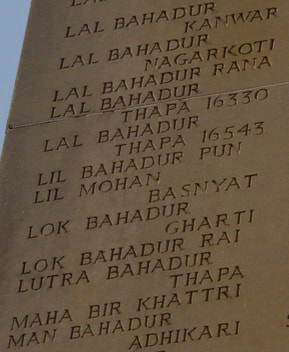 Face 57 of the Rangoon Memorial.
Face 57 of the Rangoon Memorial.
Rifleman Lal Bahadur Thapa. Sometimes it is difficult to accurately identify Gurkha soldiers, especially if they have become casualties of war. The photograph to the left shows an image of Face 57 of the Rangoon Memorial, it displays amongst other names, two men called Lal Bahadur Thapa. I am afraid to say that I cannot be certain that either of these men is the man referred to in this story, but I hope that the gesture will be understood as well meaning in an attempt to illustrate the sacrifice given by these brave soldiers.
Lal Bahadur Thapa was a young teenage recruit to the 3/2 Gurkha Rifles in 1942, he served with Column 2 on Operation Longcloth under the overall command of Major Arthur Emmett. Lal Bahadur lost his life on March 2nd 1943 during the infamous and violent clash with the enemy at the railway station town of Kyaikthin. The engagement would turn out to be the last cohesive action of Column 2 as complete group and cost the column many lives. The narrative of the battle is covered many times over on this website and therefore does not warrant repeating once again here. Suffice to say it was Chindit Column 2's 'Waterloo'
Rifleman Thapa's platoon officer was 2nd Lieutenant Ian MacHorton, and it is from his book, 'Safer Than the Known Way', that we can learn about the young Gurkhas sad demise. At last the sound of battle has faded away and the young officer begins to take stock of the situation:
"My next duty as an officer was suddenly urgent. We must close up and keep contact. Whoever was on either side of me must be formed under my command into an integrated fighting force. "Kulbahadur," I whispered, "Is there anyone on your right?" I asked. There was a pause of some seconds and then, having peered into the darkness, "I can't see anyone, Sahib. Shall I go and look?"
"Yes. But very quietly," I said.
There came the clink of his empty cartridge cases, dislodged by his movements, striking the flints as they rolled down the embankment. Then silence again. A few minutes later, with a stealthy scuffling, he crawled up beside me to whisper in my ear. "I have found no one, Sahib. Except four or five dead men."
So I turned to the Gurkha soldier lying immediately to my left to find out from him who I had with me on that side.
"Pass the word down," I told him. "Make contact with the man on your left."
As if lost in thought the Gurkha soldier continued to stare fixedly at the impenetrable shadows of the jungle ahead of him across the embankment. His honey-coloured hands held his rifle in readiness, the taut readiness of a trained soldier ready for the next Jap attack. His obvious vigilance gave me an added sense of security.
What better fighting soldiers could a young British Officer wish for on each side of him than Gurkhas. For all his eagerness to be ready should another Jap charge come, this Gurkha must do what he was told. Impatiently I repeated my order, and when he still took no notice I exclaimed "Eh—timi !" and stretched out my hand and pushed his shoulder roughly. He rolled over languidly and, amid an avalanche of small stones, slithered to the bottom of the embankment.
He lay there in a crumpled heap, his upturned young face glistened in the moonlight. I lay paralysed. The hasty hot words of reprimand were never said. I could only stare in horror at the smiling Gurkha boy who was younger even than I. I knew men were killed in war but it had never occurred to me that those I knew and liked would be killed. And killed beside me at that. Rifleman Lal Bahadur Thapa would never answer to my orders again.
Lal Bahadur had been close to me from the day I joined the Chindits back at Jhansi. Somehow or other he had always seemed to be there. All through those days of marching since we had crossed the Chindwin I had been somehow aware of his smiling young face, his virile young presence, marching onwards close to me. He was I knew little more than sixteen years old, and it was almost impossible to reconcile the grinning, tireless, Lal Bahadur with that body, which I could now see had a ragged hole the size of half a saucer in the back of the head, lying grotesquely at the embankment's foot.
I was jolted back into reality by a new outburst of firing behind us. It was unmistakably a Japanese light machine-gun. I reacted at once. It was as though I were someone else and in a dream. Shouting for my men to follow me, though not even knowing who "my men" were, I jumped up and ran crouching down to crash through into the cover of the jungle."
Lal Bahadur Thapa was a young teenage recruit to the 3/2 Gurkha Rifles in 1942, he served with Column 2 on Operation Longcloth under the overall command of Major Arthur Emmett. Lal Bahadur lost his life on March 2nd 1943 during the infamous and violent clash with the enemy at the railway station town of Kyaikthin. The engagement would turn out to be the last cohesive action of Column 2 as complete group and cost the column many lives. The narrative of the battle is covered many times over on this website and therefore does not warrant repeating once again here. Suffice to say it was Chindit Column 2's 'Waterloo'
Rifleman Thapa's platoon officer was 2nd Lieutenant Ian MacHorton, and it is from his book, 'Safer Than the Known Way', that we can learn about the young Gurkhas sad demise. At last the sound of battle has faded away and the young officer begins to take stock of the situation:
"My next duty as an officer was suddenly urgent. We must close up and keep contact. Whoever was on either side of me must be formed under my command into an integrated fighting force. "Kulbahadur," I whispered, "Is there anyone on your right?" I asked. There was a pause of some seconds and then, having peered into the darkness, "I can't see anyone, Sahib. Shall I go and look?"
"Yes. But very quietly," I said.
There came the clink of his empty cartridge cases, dislodged by his movements, striking the flints as they rolled down the embankment. Then silence again. A few minutes later, with a stealthy scuffling, he crawled up beside me to whisper in my ear. "I have found no one, Sahib. Except four or five dead men."
So I turned to the Gurkha soldier lying immediately to my left to find out from him who I had with me on that side.
"Pass the word down," I told him. "Make contact with the man on your left."
As if lost in thought the Gurkha soldier continued to stare fixedly at the impenetrable shadows of the jungle ahead of him across the embankment. His honey-coloured hands held his rifle in readiness, the taut readiness of a trained soldier ready for the next Jap attack. His obvious vigilance gave me an added sense of security.
What better fighting soldiers could a young British Officer wish for on each side of him than Gurkhas. For all his eagerness to be ready should another Jap charge come, this Gurkha must do what he was told. Impatiently I repeated my order, and when he still took no notice I exclaimed "Eh—timi !" and stretched out my hand and pushed his shoulder roughly. He rolled over languidly and, amid an avalanche of small stones, slithered to the bottom of the embankment.
He lay there in a crumpled heap, his upturned young face glistened in the moonlight. I lay paralysed. The hasty hot words of reprimand were never said. I could only stare in horror at the smiling Gurkha boy who was younger even than I. I knew men were killed in war but it had never occurred to me that those I knew and liked would be killed. And killed beside me at that. Rifleman Lal Bahadur Thapa would never answer to my orders again.
Lal Bahadur had been close to me from the day I joined the Chindits back at Jhansi. Somehow or other he had always seemed to be there. All through those days of marching since we had crossed the Chindwin I had been somehow aware of his smiling young face, his virile young presence, marching onwards close to me. He was I knew little more than sixteen years old, and it was almost impossible to reconcile the grinning, tireless, Lal Bahadur with that body, which I could now see had a ragged hole the size of half a saucer in the back of the head, lying grotesquely at the embankment's foot.
I was jolted back into reality by a new outburst of firing behind us. It was unmistakably a Japanese light machine-gun. I reacted at once. It was as though I were someone else and in a dream. Shouting for my men to follow me, though not even knowing who "my men" were, I jumped up and ran crouching down to crash through into the cover of the jungle."
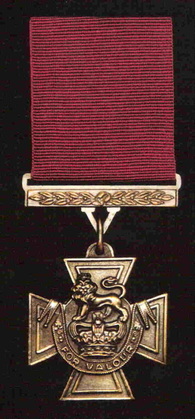 The Victoria Cross medal.
The Victoria Cross medal.
Naik Bhanbhagta Gurung VC.
An Inspiring Example
Bhanbhagta Gurung was born in Phalpu in 1921 and joined 3/2 Gurkha Rifles in 1940. Prior to the ferocious final battles of WWII where he would earn his VC, the soldier had fought in the first Chindit expedition. The grueling Operation Longcloth saw Bhanbhagta and a legion of 3,000 determined men march some 1,500 miles through dense Burmese jungle to inflict devastating strikes against the enemy.
3/2 GR were not part of the second Chindit operation of 1944. That task fell to 4th, 6th and 9th Gurkha Rifles. Instead 3/2’s mission was to engage the enemy in diversionary action along the Arakan coastline. In February 1945, the battalion landed at Ruywa and tenaciously battled its way to Tamandu. Here, the battalion were tasked with overcoming the formidable Japanese 54th Division to capture the area and hold the dominant feature, Pt. 582 nicknamed Snowdon East.
‘A’ Company’s objective was to capture and hold Snowdon, allowing West African troops to evacuate their wounded. ‘A’ company achieved its objective without opposition. However the Japanese counter-attacked, killing half the Gurkhas on Snowdon. The next day, Bhanbhagta’s ‘B’ Company was ordered to retake Snowdon East, ‘regardless of the cost’. ‘B’ Company advanced under heavy fire. In driving forward, half of Bhanbhagta’s comrades fell. Light machine guns then pinned the Company to the ground.
The accurate shots of a tree sniper 75 yards away picked off men one by one. Unable to fire from the lying position, Bhanbhagta stood up, fully exposed to the heavy fire and calmly killed the enemy sniper with his rifle. Free of the sniper’s harassment, ‘B’ Company advanced another 20 yards before further heavy fire rained down. Bhanbhagta rushed forward alone and attacked the first enemy foxhole, throwing two grenades to kill its two occupants. He rushed to the next foxhole, running his bayonet through two more Japanese. Bhanbhagta’s attention turned to two more enemy foxholes and again, he dashed forward, clearing the positions with his bayonet and grenades.
All the while, light machine gun fire targeted Bhanbhagta at point blank range. Realising this harassment would impede ‘B’ Company’s progress; he went forward for a fifth time. The citation says, ‘he ran forward and leapt on to the roof of the bunker, from where his hand grenades being finished, he flung two No.77 smoke grenades into the bunker slit.’ Blinded by the smoke the Japanese burst from the bunker, whereupon Bhanbhagta killed them with his kukri. A third machine gunner remained in the bunker desperately holding off No. 4 Platoon. Bhanbhagta crawled in and without the space to wield a bayonet or kukri, used a rock to kill the gunner.
As the Japanese counter attacked, Bhanbhagta rallied ‘B’ Company to hold the captured bunker, secure their position and repel the enemy’s advance.
Bhanbhagta’s actions were described as an ‘inspiring example’. As well as earning him a VC, this action gained the Regiment the battle honour, ‘Tamandu’.
At the end of the War, he returned to Nepal where his duties to a frail widowed mother and young wife in Gorkha beckoned.
In recent years, ill health left Bhanbhagta housebound at his son’s home. He passed away in Gorkha as a man respected by many, but best described by his Company Commander as ‘a smiling, hard swearing and indomitable solider who in a battalion of brave men was one of the bravest.’
This article is reproduced courtesy of the Spring 2008 edition of Samachara, the newsletter of the Gurkha Welfare Trust. The Trust’s work in the Hills around the former home of Bhanbhagta and beyond, stands as a lasting tribute to his gallantry and that of Gurkhas everywhere.
To read this brave soldiers obituary, please click on the link below:
http://www.independent.co.uk/news/obituaries/bhanbhagta-gurung-vc-soldier-who-saved-fellow-gurkhas-795695.html
Seen below are some photographs of Bhanbhagta Gurung and his time with the 2nd Gurkha Rifles. Please click on any image to bring it forward on the page.
An Inspiring Example
Bhanbhagta Gurung was born in Phalpu in 1921 and joined 3/2 Gurkha Rifles in 1940. Prior to the ferocious final battles of WWII where he would earn his VC, the soldier had fought in the first Chindit expedition. The grueling Operation Longcloth saw Bhanbhagta and a legion of 3,000 determined men march some 1,500 miles through dense Burmese jungle to inflict devastating strikes against the enemy.
3/2 GR were not part of the second Chindit operation of 1944. That task fell to 4th, 6th and 9th Gurkha Rifles. Instead 3/2’s mission was to engage the enemy in diversionary action along the Arakan coastline. In February 1945, the battalion landed at Ruywa and tenaciously battled its way to Tamandu. Here, the battalion were tasked with overcoming the formidable Japanese 54th Division to capture the area and hold the dominant feature, Pt. 582 nicknamed Snowdon East.
‘A’ Company’s objective was to capture and hold Snowdon, allowing West African troops to evacuate their wounded. ‘A’ company achieved its objective without opposition. However the Japanese counter-attacked, killing half the Gurkhas on Snowdon. The next day, Bhanbhagta’s ‘B’ Company was ordered to retake Snowdon East, ‘regardless of the cost’. ‘B’ Company advanced under heavy fire. In driving forward, half of Bhanbhagta’s comrades fell. Light machine guns then pinned the Company to the ground.
The accurate shots of a tree sniper 75 yards away picked off men one by one. Unable to fire from the lying position, Bhanbhagta stood up, fully exposed to the heavy fire and calmly killed the enemy sniper with his rifle. Free of the sniper’s harassment, ‘B’ Company advanced another 20 yards before further heavy fire rained down. Bhanbhagta rushed forward alone and attacked the first enemy foxhole, throwing two grenades to kill its two occupants. He rushed to the next foxhole, running his bayonet through two more Japanese. Bhanbhagta’s attention turned to two more enemy foxholes and again, he dashed forward, clearing the positions with his bayonet and grenades.
All the while, light machine gun fire targeted Bhanbhagta at point blank range. Realising this harassment would impede ‘B’ Company’s progress; he went forward for a fifth time. The citation says, ‘he ran forward and leapt on to the roof of the bunker, from where his hand grenades being finished, he flung two No.77 smoke grenades into the bunker slit.’ Blinded by the smoke the Japanese burst from the bunker, whereupon Bhanbhagta killed them with his kukri. A third machine gunner remained in the bunker desperately holding off No. 4 Platoon. Bhanbhagta crawled in and without the space to wield a bayonet or kukri, used a rock to kill the gunner.
As the Japanese counter attacked, Bhanbhagta rallied ‘B’ Company to hold the captured bunker, secure their position and repel the enemy’s advance.
Bhanbhagta’s actions were described as an ‘inspiring example’. As well as earning him a VC, this action gained the Regiment the battle honour, ‘Tamandu’.
At the end of the War, he returned to Nepal where his duties to a frail widowed mother and young wife in Gorkha beckoned.
In recent years, ill health left Bhanbhagta housebound at his son’s home. He passed away in Gorkha as a man respected by many, but best described by his Company Commander as ‘a smiling, hard swearing and indomitable solider who in a battalion of brave men was one of the bravest.’
This article is reproduced courtesy of the Spring 2008 edition of Samachara, the newsletter of the Gurkha Welfare Trust. The Trust’s work in the Hills around the former home of Bhanbhagta and beyond, stands as a lasting tribute to his gallantry and that of Gurkhas everywhere.
To read this brave soldiers obituary, please click on the link below:
http://www.independent.co.uk/news/obituaries/bhanbhagta-gurung-vc-soldier-who-saved-fellow-gurkhas-795695.html
Seen below are some photographs of Bhanbhagta Gurung and his time with the 2nd Gurkha Rifles. Please click on any image to bring it forward on the page.
Havildar Lalbahadur Thapa. This Gurkha NCO was a member of Column 2 in 1943. He, like all the other men from this ill-fated column, was to suffer greatly during the catastrophic ambush by the Japanese on the night of the 2nd March. Lalbahadur had skilfully extricated his platoon that night and moved quickly away in to the nearby woodland. The group settled down for an hour or so, but then decided to move on, in an attempt to put some distance between themselves and the enemy.
At roughly the same time Lieutenant Ian MacHorton and his small group were in the process of throwing off an attack by a section of Japanese, who had followed him and his men into the same jungle scrub. From the book, 'Wingate's Lost Brigade' :
MacHorton and his Gurkhas heard the sound of the Japanese behind them and turned at right angles to try to shake off the pursuers. They found a track and followed it towards some high ground where British Bren guns were exchanging fire with Japanese light machine-guns and rifles. Ordering his men to stack their heavy packs at the edge of the track, the young officer led his men forward and into a dry chaung which meandered towards the British positions.
Suddenly one of his Gurkhas cried out: `Japun yo' and began to fire back down the chaung at the shadowy figures with their smooth-domed steel helmets reflecting the moonlight. The darkness was lit by red and yellow flashes as both sides opened fire on each other.
Japanese bayonets and Gurkha kukris flashed in the darkness as the men scuffled and fought to the death. When the guns fell silent the Japanese lay dead at their feet, but there had been casualties on both sides. Naik Premsingh Gurung lay groaning on the ground, his thigh bone smashed by a bullet fired at close range. He had given a good account of himself though, as on the ground nearby lay a Jap with Premsingh's kukri buried in his neck.
The wounded man was given a shot of morphine while his wound was dressed and bamboo splints were tied to his shattered leg. MacHorton and his men were then joined by Havildar Lalbahadur Thapa and five more Gurkhas who, like MacHorton had neither seen nor heard of the rest of the column since the ambush. The exhausted men slumped to the ground to await the coming of dawn.
After a restless few hours MacHorton awoke and began to take stock of the situation. From his own book written about the first Chindit operation, 'Safer Than a Known Way':
"I watched the first grey streaks of dawn steal through the towering black mass of the teak trees around us. As I watched, their foliage merged almost imperceptibly from black to deep purple and then from purple through lessening darkness until finally they were green. Once more jungle night was becoming jungle day. But this was a day different from all the others. As far as I could see there was myself, my six Gurkhas and the badly wounded Premsingh, and Havildar Lalbahdur Thapa and his five Gurkhas. Were we the sole survivors of the whole column? "
Sadly, Lalbahadur did not make back to India from Operation Longcloth and was killed in action on the 10th April 1943, during an engagement with the enemy just south of Mong Mit.
At roughly the same time Lieutenant Ian MacHorton and his small group were in the process of throwing off an attack by a section of Japanese, who had followed him and his men into the same jungle scrub. From the book, 'Wingate's Lost Brigade' :
MacHorton and his Gurkhas heard the sound of the Japanese behind them and turned at right angles to try to shake off the pursuers. They found a track and followed it towards some high ground where British Bren guns were exchanging fire with Japanese light machine-guns and rifles. Ordering his men to stack their heavy packs at the edge of the track, the young officer led his men forward and into a dry chaung which meandered towards the British positions.
Suddenly one of his Gurkhas cried out: `Japun yo' and began to fire back down the chaung at the shadowy figures with their smooth-domed steel helmets reflecting the moonlight. The darkness was lit by red and yellow flashes as both sides opened fire on each other.
Japanese bayonets and Gurkha kukris flashed in the darkness as the men scuffled and fought to the death. When the guns fell silent the Japanese lay dead at their feet, but there had been casualties on both sides. Naik Premsingh Gurung lay groaning on the ground, his thigh bone smashed by a bullet fired at close range. He had given a good account of himself though, as on the ground nearby lay a Jap with Premsingh's kukri buried in his neck.
The wounded man was given a shot of morphine while his wound was dressed and bamboo splints were tied to his shattered leg. MacHorton and his men were then joined by Havildar Lalbahadur Thapa and five more Gurkhas who, like MacHorton had neither seen nor heard of the rest of the column since the ambush. The exhausted men slumped to the ground to await the coming of dawn.
After a restless few hours MacHorton awoke and began to take stock of the situation. From his own book written about the first Chindit operation, 'Safer Than a Known Way':
"I watched the first grey streaks of dawn steal through the towering black mass of the teak trees around us. As I watched, their foliage merged almost imperceptibly from black to deep purple and then from purple through lessening darkness until finally they were green. Once more jungle night was becoming jungle day. But this was a day different from all the others. As far as I could see there was myself, my six Gurkhas and the badly wounded Premsingh, and Havildar Lalbahdur Thapa and his five Gurkhas. Were we the sole survivors of the whole column? "
Sadly, Lalbahadur did not make back to India from Operation Longcloth and was killed in action on the 10th April 1943, during an engagement with the enemy just south of Mong Mit.
Lance Naik Parbhu Sing Thapa, Naik Subakhar Thapa and Jemadar Jangdhoj Rana
The three men featured above were members of Southern Group on Operation Longcloth in 1943. It is difficult to accurately identify their exact Chindit Column for that year, but all of them ended up members of the amalgamated group after the disaster at Kyaikthin and continued their Burmese odyssey under the command of Major George Dunlop, regaining the Indian Border by late April or early May.
Jangdhoj Rana had been one of the original Gurkha Officers to travel over to Chindit training at Saugor in mid-1942, having previously been stationed with the battalion close to the North West Frontier. Nothing else is known of Lance Naik Parbhu, but I do know that Subakhar Thapa was promoted to Havildar during, or shortly after Operation Longcloth.
Naik Jhuriman Rai
This brave Gurkha NCO had joined the strength of Column 5 as a muleteer during Chindit training at Jhansi in late 1942. He formed part of Animal Transport Officer, Bill Smyly's platoon on Operation Longcloth. During the early weeks of the expedition he had continually pestered his Platoon Commander for more exciting duties. Lieutenant Smyly had more than a little sympathy for his impatient Naik, as he too was hoping for more stimulating work.
As Column 5 approached the Mandalay-Myitkhina Railway in early March 1943, Jhuriman would be given his chance. From the book, 'Safer than a Known Way', by Gurkha Officer Ian MacHorton:
On 6 March, three days after we (Column 2) had been so savagely mauled in the battle of Kyaikthin, a patrol headed by Tommy Roberts of Bernard Fergusson's Column had collided head on with a Japanese force in a village near the Bonchaung Gorge.
In the ensuing fighting some twenty Japanese had been killed and it was there that Bernard had himself been confronted for the first time with the problem of what to do with his wounded.
Eventually he had been forced to leave three of them, with their packs containing food and earthen jars of water beside them, in the shade of one of the houses in the village. Two others had to be left beside a jungle track because they were too badly wounded to move.
Captain Roberts's patrol had surprised a lorry-load of Japs just settling down in their truck ready to drive off and look for British soldiers. They found them without having to look. The hail of fire the British brought down on the lorry was thought to have killed every Jap except the driver, who unfortunately had been able to drive away. Undoubtedly he would lose no time in returning with reinforcements.
The advance guard of Bernard Fergusson's Column now in the bivouac area with Mike Calvert's troops, were enthusiastic in their admiration of the execution wrought by one sturdy Naik standing no more than 5 feet 2 inches high. By name Jhuriman Rai, he had pressed his attack home with such ferocity that he had killed five Japs single-handed. Three had fallen to his rifle and two he had slashed down with his kukri. The fact that five bullet holes were later found in his clothing showed how fearlessly the grinning little Gurkha had gone into the fight.
As mentioned by Ian MacHorton, Bernard Fergusson had taken care of his wounded at Kyaik-in, this included Lieutenant John Kerr, who before allowing himself to be treated for his own wound insisted on telling his Major what had happened. After making sure the men were comfortable and arranging for the headman of Kyaik-in village to assume on-going care, Major Fergusson assessed the enemy's losses.
From his own book entitled 'Beyond the Chindwin', this is how he described the incident on the 6th March:
Sixteen dead Japanese were counted in and around the village. It was thought that the one who got away in the lorry was the only survivor. One Gurkha Naik, by name Jhuriman Rai—one of six whom I had sent with Tommy (Roberts) as a change from muleteering—killed no less than five of them, three with his rifle and two with his kukri.
Jhuriman had originally been a member of Bill Smyly's Animal Transport platoon where he had tended one of the column's mules. Naik Jhuriman returned to Smyly's care later in the expedition and eventually dispersed with the officer, escaping Burma in July via Fort Hertz in the far north of the country.
Seen below is a small map showing the immediate area around the village of Kyaik-in, the scene of Jhuriman Rai's heroic action in March 1943. Please click on the image to bring it forward on the page.
The three men featured above were members of Southern Group on Operation Longcloth in 1943. It is difficult to accurately identify their exact Chindit Column for that year, but all of them ended up members of the amalgamated group after the disaster at Kyaikthin and continued their Burmese odyssey under the command of Major George Dunlop, regaining the Indian Border by late April or early May.
Jangdhoj Rana had been one of the original Gurkha Officers to travel over to Chindit training at Saugor in mid-1942, having previously been stationed with the battalion close to the North West Frontier. Nothing else is known of Lance Naik Parbhu, but I do know that Subakhar Thapa was promoted to Havildar during, or shortly after Operation Longcloth.
Naik Jhuriman Rai
This brave Gurkha NCO had joined the strength of Column 5 as a muleteer during Chindit training at Jhansi in late 1942. He formed part of Animal Transport Officer, Bill Smyly's platoon on Operation Longcloth. During the early weeks of the expedition he had continually pestered his Platoon Commander for more exciting duties. Lieutenant Smyly had more than a little sympathy for his impatient Naik, as he too was hoping for more stimulating work.
As Column 5 approached the Mandalay-Myitkhina Railway in early March 1943, Jhuriman would be given his chance. From the book, 'Safer than a Known Way', by Gurkha Officer Ian MacHorton:
On 6 March, three days after we (Column 2) had been so savagely mauled in the battle of Kyaikthin, a patrol headed by Tommy Roberts of Bernard Fergusson's Column had collided head on with a Japanese force in a village near the Bonchaung Gorge.
In the ensuing fighting some twenty Japanese had been killed and it was there that Bernard had himself been confronted for the first time with the problem of what to do with his wounded.
Eventually he had been forced to leave three of them, with their packs containing food and earthen jars of water beside them, in the shade of one of the houses in the village. Two others had to be left beside a jungle track because they were too badly wounded to move.
Captain Roberts's patrol had surprised a lorry-load of Japs just settling down in their truck ready to drive off and look for British soldiers. They found them without having to look. The hail of fire the British brought down on the lorry was thought to have killed every Jap except the driver, who unfortunately had been able to drive away. Undoubtedly he would lose no time in returning with reinforcements.
The advance guard of Bernard Fergusson's Column now in the bivouac area with Mike Calvert's troops, were enthusiastic in their admiration of the execution wrought by one sturdy Naik standing no more than 5 feet 2 inches high. By name Jhuriman Rai, he had pressed his attack home with such ferocity that he had killed five Japs single-handed. Three had fallen to his rifle and two he had slashed down with his kukri. The fact that five bullet holes were later found in his clothing showed how fearlessly the grinning little Gurkha had gone into the fight.
As mentioned by Ian MacHorton, Bernard Fergusson had taken care of his wounded at Kyaik-in, this included Lieutenant John Kerr, who before allowing himself to be treated for his own wound insisted on telling his Major what had happened. After making sure the men were comfortable and arranging for the headman of Kyaik-in village to assume on-going care, Major Fergusson assessed the enemy's losses.
From his own book entitled 'Beyond the Chindwin', this is how he described the incident on the 6th March:
Sixteen dead Japanese were counted in and around the village. It was thought that the one who got away in the lorry was the only survivor. One Gurkha Naik, by name Jhuriman Rai—one of six whom I had sent with Tommy (Roberts) as a change from muleteering—killed no less than five of them, three with his rifle and two with his kukri.
Jhuriman had originally been a member of Bill Smyly's Animal Transport platoon where he had tended one of the column's mules. Naik Jhuriman returned to Smyly's care later in the expedition and eventually dispersed with the officer, escaping Burma in July via Fort Hertz in the far north of the country.
Seen below is a small map showing the immediate area around the village of Kyaik-in, the scene of Jhuriman Rai's heroic action in March 1943. Please click on the image to bring it forward on the page.
Havildar Merbir Pun and Naik Chandra Singh
During the first Chindit operation in 1943 both these Gurkhas belonged to No. 9 Rifle Platoon in Column 1. The Column was commanded by former Black Watch Officer, Major George Dunlop MC. Dunlop had replaced Gurkha Officer Vivian Weatherall as commander of Column 1, just before the brigade completed its training in late December 1942. It has long been a matter for discussion in Chindit circles, whether it was a wise move to replace well respected and indeed loved Gurkha Officers with British counterparts, so late in the day. This topic has been mentioned within the pages of this website before and many have concluded that the decision was a grave error and that it hindered communication between officers and men within the Gurkha Columns in 1943.
Column 1 made up one half of the Southern Section in 1943, ordered to provide a decoy for Wingate and his Chindit Columns in Northern Group. By the time dispersal was called on the 29th March, Column 1 found itself the furthest east of all the Chindit units. Close to the Myitson-Mongmit motor road and unsure whether to exit Burma via the Chinese borders or return west to India, Dunlop moved his men towards the nearby foothills. They were ambushed by a Japanese patrol half-way up these hills, sustaining many casualties, but also losing their wireless set to an enemy bullet.
Now, unable to contact Rear Base for new supplies, Dunlop decided he had no choice but to return the way he had come and turned his men westward. By the 22nd April the column had reached the east banks of the Irrawaddy River near a village called Tagaung. Merbir Pun and Naik Chandra Singh were part of a section led by Lieutenant Robert Peter Wormell and had been ordered over the river to form a security bridgehead on the west bank.
The group of about ten men made the far bank with no problems and Lt. Wormell gave an order to Merbir to take half the section and head north along the riverside track for approximately 300 yards. Wormell headed south for the same distance and satisfied that there was no sign of the enemy, returned to the bridgehead position and awaited the arrival of Havildar Merbir Pun. After waiting a few minutes, Wormell decided to investigate the pathway the other section had taken.
After travelling approximately 150 yards, Lieut. Wormell suddenly heard a rustling noise coming from the jungle undergrowth ahead. Treading carefully he approached the undergrowth as silently as he could. Gently pushing back some thickset bamboo, the Lieutenant came face to face with a Japanese sentry, both men froze, each man surprised to see the other. Coming at last to his senses, the Gurkha Officer turned quickly and ran back down the riverside track, gunfire following his movements just seconds after.
Wormell realised that Merbir's section, which included Naik Chandra Singh, had walked straight in to this enemy patrol and had been either captured or killed. The enemy positions in that area then interfered greatly with the rest of the column now crossing the river, with many men lost or killed in the Irrawaddy that day.
Nothing more was heard of Merbir Pun, he does not feature in any missing in action files, POW lists, or on any casualty rolls for the 3/2 Gurkha Rifles. Could it be that he actually escaped capture on the 22nd April and made his own way back to India that year?
Sadly, Naik Chandra Singh does feature in the casualty rolls for the battalion and was probably killed on, or shortly after the 22nd April 1943.
Lieutenant Wormell, although managing to escape capture at the Irrawaddy crossing was taken prisoner a few days later on the 1st May. He was eventually taken down to Rangoon Central Jail, where he spent the next two years as a POW. His POW number in the jail was 44.
Seen below are a map of the area around the Irrawaddy River and the village Tagaung, where Merbir and Chandra Singh went missing. Also shown is a copy of Lieutenant Wormell's prisoner of war index card. Please click on either image to bring it forward on the page.
During the first Chindit operation in 1943 both these Gurkhas belonged to No. 9 Rifle Platoon in Column 1. The Column was commanded by former Black Watch Officer, Major George Dunlop MC. Dunlop had replaced Gurkha Officer Vivian Weatherall as commander of Column 1, just before the brigade completed its training in late December 1942. It has long been a matter for discussion in Chindit circles, whether it was a wise move to replace well respected and indeed loved Gurkha Officers with British counterparts, so late in the day. This topic has been mentioned within the pages of this website before and many have concluded that the decision was a grave error and that it hindered communication between officers and men within the Gurkha Columns in 1943.
Column 1 made up one half of the Southern Section in 1943, ordered to provide a decoy for Wingate and his Chindit Columns in Northern Group. By the time dispersal was called on the 29th March, Column 1 found itself the furthest east of all the Chindit units. Close to the Myitson-Mongmit motor road and unsure whether to exit Burma via the Chinese borders or return west to India, Dunlop moved his men towards the nearby foothills. They were ambushed by a Japanese patrol half-way up these hills, sustaining many casualties, but also losing their wireless set to an enemy bullet.
Now, unable to contact Rear Base for new supplies, Dunlop decided he had no choice but to return the way he had come and turned his men westward. By the 22nd April the column had reached the east banks of the Irrawaddy River near a village called Tagaung. Merbir Pun and Naik Chandra Singh were part of a section led by Lieutenant Robert Peter Wormell and had been ordered over the river to form a security bridgehead on the west bank.
The group of about ten men made the far bank with no problems and Lt. Wormell gave an order to Merbir to take half the section and head north along the riverside track for approximately 300 yards. Wormell headed south for the same distance and satisfied that there was no sign of the enemy, returned to the bridgehead position and awaited the arrival of Havildar Merbir Pun. After waiting a few minutes, Wormell decided to investigate the pathway the other section had taken.
After travelling approximately 150 yards, Lieut. Wormell suddenly heard a rustling noise coming from the jungle undergrowth ahead. Treading carefully he approached the undergrowth as silently as he could. Gently pushing back some thickset bamboo, the Lieutenant came face to face with a Japanese sentry, both men froze, each man surprised to see the other. Coming at last to his senses, the Gurkha Officer turned quickly and ran back down the riverside track, gunfire following his movements just seconds after.
Wormell realised that Merbir's section, which included Naik Chandra Singh, had walked straight in to this enemy patrol and had been either captured or killed. The enemy positions in that area then interfered greatly with the rest of the column now crossing the river, with many men lost or killed in the Irrawaddy that day.
Nothing more was heard of Merbir Pun, he does not feature in any missing in action files, POW lists, or on any casualty rolls for the 3/2 Gurkha Rifles. Could it be that he actually escaped capture on the 22nd April and made his own way back to India that year?
Sadly, Naik Chandra Singh does feature in the casualty rolls for the battalion and was probably killed on, or shortly after the 22nd April 1943.
Lieutenant Wormell, although managing to escape capture at the Irrawaddy crossing was taken prisoner a few days later on the 1st May. He was eventually taken down to Rangoon Central Jail, where he spent the next two years as a POW. His POW number in the jail was 44.
Seen below are a map of the area around the Irrawaddy River and the village Tagaung, where Merbir and Chandra Singh went missing. Also shown is a copy of Lieutenant Wormell's prisoner of war index card. Please click on either image to bring it forward on the page.
Amar Sing Gurung formed part of a very special and tight-knit Gurkha Section within 4 Column on Operation Longcloth. Ably led by Lt. J.H. Stewart-Jones, formerly of the Royal Scots, this small group were destined to play a significant role in many of the Brigade's actions against the Japanese in 1943.
4 Column were one of the two Gurkha columns attached to Northern Group and were commanded in the first instance by Major Philip Conron. Unfortunately, not long into the operation, Wingate found it necessary to replace Major Conron and ordered his then Brigade-Major, George Bromhead to take over command. The column's fortunes did not improve however, and on the 4th March, they were attacked by the enemy whilst marching through a narrow forest track and the unit was spilt in two.
To help explain the situation further, here is an extract from the book, Wingate's Lost Brigade, by author Phil Chinnery:
During the morning of 4th March, while the column was marching south-east along the base of the mountains, all hell broke loose. The column was in the usual single-file 'snake' formation and strung out over 1,000 yards when the undergrowth came alive with enemy small arms fire. Half of the formation had already crossed a small stream, when a shower of enemy mortar bombs began to fall on the ford, preventing the rest from crossing. The column had walked into a trap. While a rearguard platoon held the enemy at the stream, Lieutenants Stewart-Jones and Green and Subedar Tikajit Pun led 135 men and thirty mules away to the north. The remainder of the column that had already crossed the stream dispersed in small groups and headed for the pre-arranged rendezvous twenty miles to the south.
Another Gurkha Officer with 4 Column in 1943 was Captain David Oldrini. As Adjutant, he was given the task of keeping the column War diary during Operation Longcloth and here is how he recalled the events leading up to Japanese ambush:
We left our little area just west of the motor road at dawn on the 4th March. We set off in the usual Column 'snake' and after about three hours marching we came to the village of Kyaungle. The only way we could get passed this village with the mules was along a small track through the forest just a few yards to the east. When the column was nicely placed along this track, without warning, every possible type of weapon seemed to open up on us. Animals immediately started to panic and there was no holding them. Loads had been thrown right and left and caught up in branches, leaving nothing but a stampeding mass of mules. This was at about 10:00 hours. Men dispersed and took up positions as best they could and the battle continued for about two and a half hours. We were unable to get our mortars into action, but we fired our Vickers guns until they were out of ammunition and the men used their grenades to good effect.
After breaking away from the enemy, we found our wireless was out of order, so we could not call up for air supply droppings of food and ammunition. We were by then all out of food and our last supply drop had been on the 26th February. As we did not know where Brigade had gone and could no longer get in touch with them, there was nothing for it but to turn back to India. The villages in that area were full of Japs so we could not get food supplies in that way. We had a small amount of mule grain left, so we shared this out and set off on the homeward journey. After we had re-crossed the escarpment we were able to get rice in local villages and each man had half a cupful of rice each day, together with mule flesh for those who could eat it. Eventually we re-crossed the Chindwin River and on into Assam once more.
To read more about 4 Column and their experiences during the first Chindit expedition in 1943, please click on the following link:
Major Bromhead and 4 Column
4 Column were one of the two Gurkha columns attached to Northern Group and were commanded in the first instance by Major Philip Conron. Unfortunately, not long into the operation, Wingate found it necessary to replace Major Conron and ordered his then Brigade-Major, George Bromhead to take over command. The column's fortunes did not improve however, and on the 4th March, they were attacked by the enemy whilst marching through a narrow forest track and the unit was spilt in two.
To help explain the situation further, here is an extract from the book, Wingate's Lost Brigade, by author Phil Chinnery:
During the morning of 4th March, while the column was marching south-east along the base of the mountains, all hell broke loose. The column was in the usual single-file 'snake' formation and strung out over 1,000 yards when the undergrowth came alive with enemy small arms fire. Half of the formation had already crossed a small stream, when a shower of enemy mortar bombs began to fall on the ford, preventing the rest from crossing. The column had walked into a trap. While a rearguard platoon held the enemy at the stream, Lieutenants Stewart-Jones and Green and Subedar Tikajit Pun led 135 men and thirty mules away to the north. The remainder of the column that had already crossed the stream dispersed in small groups and headed for the pre-arranged rendezvous twenty miles to the south.
Another Gurkha Officer with 4 Column in 1943 was Captain David Oldrini. As Adjutant, he was given the task of keeping the column War diary during Operation Longcloth and here is how he recalled the events leading up to Japanese ambush:
We left our little area just west of the motor road at dawn on the 4th March. We set off in the usual Column 'snake' and after about three hours marching we came to the village of Kyaungle. The only way we could get passed this village with the mules was along a small track through the forest just a few yards to the east. When the column was nicely placed along this track, without warning, every possible type of weapon seemed to open up on us. Animals immediately started to panic and there was no holding them. Loads had been thrown right and left and caught up in branches, leaving nothing but a stampeding mass of mules. This was at about 10:00 hours. Men dispersed and took up positions as best they could and the battle continued for about two and a half hours. We were unable to get our mortars into action, but we fired our Vickers guns until they were out of ammunition and the men used their grenades to good effect.
After breaking away from the enemy, we found our wireless was out of order, so we could not call up for air supply droppings of food and ammunition. We were by then all out of food and our last supply drop had been on the 26th February. As we did not know where Brigade had gone and could no longer get in touch with them, there was nothing for it but to turn back to India. The villages in that area were full of Japs so we could not get food supplies in that way. We had a small amount of mule grain left, so we shared this out and set off on the homeward journey. After we had re-crossed the escarpment we were able to get rice in local villages and each man had half a cupful of rice each day, together with mule flesh for those who could eat it. Eventually we re-crossed the Chindwin River and on into Assam once more.
To read more about 4 Column and their experiences during the first Chindit expedition in 1943, please click on the following link:
Major Bromhead and 4 Column
As mentioned previously, Lt. Stewart-Jones and a party of some 135 men became separated from the main body of 4 Column at Kyaungle and moved away initially to the north, before turning back southwards in the hope of meeting up with Wingate and the other Chindit columns at the Irrawaddy. This he succeeded in doing, but not before the decision was made for the majority of the sub-section, now under the leadership of Captain Finlay, to return to India. Lt. Stewart-Jones and his section of Gurkhas, determined to continue on with the operation, pushed on east and eventually met up with Major Scott and 8 Column.
Lt. Stewart-Jones recalled:
On 10th March my patrol was asked to go back one day’s march along the track and lead in any remaining men from 4 Column. We waited in our position overlooking the track, but no men came. We returned to join Brigade after questioning the Headman of Pegon village, which lay below my O.P. (observation point). He informed us that the Japanese were expected in the village that night. About three weeks later I received news that the majority of 4 Column, under Major Bromhead had arrived back in India. On receiving this information, I and my four Gurkhas were attached to 8 Column under Major Scott. After a further two weeks, I took over No. 16 Platoon within the column, comprised mostly British Other Ranks who had been muleteers. My four Gurkhas accompanied me by arrangement with Major Scott.
It was not long before the column had nothing but admiration for these four soldiers of mine. I asked, and was given permission to promote one of the four to the rank of Naik (Corporal). I chose Amar Sing Gurung. His untiring cheerful attitude in the face of all our difficulties during those times and his intelligent appreciation of every situation, made him one of the most respected men in the whole column. From my own personal point of view, no words can possibly express my gratitude in being permitted to serve with such men as these four young Gurkha Riflemen. They were at the forefront of all subsequent actions including clearing the enemy from the village of Baw (see maps below) in late March and another incident with the Japanese at a place called Sinkan, near the banks of the Irrawaddy a few weeks later.
NB. On the 15th April, Lt. Stewart-Jones and his platoon were ordered to join up with Captain Nigel Whitehead of the Burma Rifles and assist him in escorting a party of sick and wounded Chindits to a safe and friendly Kachin village in which to leave them. This was the last time he served under Major Scott in 1943. To read more about Captain Whitehead and his mission of mercy, please click on the following link: Captain Nigel Whitehead
Lt. Stewart-Jones concludes:
Eventually, we got out via Fort Hertz and were split from one another. On my return to Dehra Dun after my hospitalisation, I searched for these men and was greatly annoyed to discover that Amar Sing Gurung had been returned to the rank of Rifleman. He had not even received the correct pay as a Naik for his time in Burma. I sent in a recommendation for all four men, explaining their great service and sterling conduct during the operation. Nothing has been done in this regard, and I should like, if no medal can be given, that mention of their deeds be added to the Regimental Records.
Sadly, nothing was ever done for Amar Sing Gurung and the other three Gurkha Riflemen in recognition of their invaluable contributions during the first Chindit expedition in 1943. All of these men went on to serve in the Arakan campaign with 3/2 Gurkha Rifles the following year.
Lt. Stewart-Jones recalled:
On 10th March my patrol was asked to go back one day’s march along the track and lead in any remaining men from 4 Column. We waited in our position overlooking the track, but no men came. We returned to join Brigade after questioning the Headman of Pegon village, which lay below my O.P. (observation point). He informed us that the Japanese were expected in the village that night. About three weeks later I received news that the majority of 4 Column, under Major Bromhead had arrived back in India. On receiving this information, I and my four Gurkhas were attached to 8 Column under Major Scott. After a further two weeks, I took over No. 16 Platoon within the column, comprised mostly British Other Ranks who had been muleteers. My four Gurkhas accompanied me by arrangement with Major Scott.
It was not long before the column had nothing but admiration for these four soldiers of mine. I asked, and was given permission to promote one of the four to the rank of Naik (Corporal). I chose Amar Sing Gurung. His untiring cheerful attitude in the face of all our difficulties during those times and his intelligent appreciation of every situation, made him one of the most respected men in the whole column. From my own personal point of view, no words can possibly express my gratitude in being permitted to serve with such men as these four young Gurkha Riflemen. They were at the forefront of all subsequent actions including clearing the enemy from the village of Baw (see maps below) in late March and another incident with the Japanese at a place called Sinkan, near the banks of the Irrawaddy a few weeks later.
NB. On the 15th April, Lt. Stewart-Jones and his platoon were ordered to join up with Captain Nigel Whitehead of the Burma Rifles and assist him in escorting a party of sick and wounded Chindits to a safe and friendly Kachin village in which to leave them. This was the last time he served under Major Scott in 1943. To read more about Captain Whitehead and his mission of mercy, please click on the following link: Captain Nigel Whitehead
Lt. Stewart-Jones concludes:
Eventually, we got out via Fort Hertz and were split from one another. On my return to Dehra Dun after my hospitalisation, I searched for these men and was greatly annoyed to discover that Amar Sing Gurung had been returned to the rank of Rifleman. He had not even received the correct pay as a Naik for his time in Burma. I sent in a recommendation for all four men, explaining their great service and sterling conduct during the operation. Nothing has been done in this regard, and I should like, if no medal can be given, that mention of their deeds be added to the Regimental Records.
Sadly, nothing was ever done for Amar Sing Gurung and the other three Gurkha Riflemen in recognition of their invaluable contributions during the first Chindit expedition in 1943. All of these men went on to serve in the Arakan campaign with 3/2 Gurkha Rifles the following year.
Lt. Ronald N. Green
Ronald Green came over to 3/2 Gurkha Rifles at a fairly late stage during the battalion's training period for Operation Longcloth, arriving at Jhansi on Christmas Eve. He had previously served with the Indian Army Cavalry unit, Hodson's Horse, before being allocated to No. 4 Column as their Animal Transport Officer. He worked in close conjunction with the column's Commando section, but his main role in the early stages of the expedition was to oversee the column's 16 bullocks and carts. These animals were used to carry heavy items such as Bren guns, Piats and other large apparatus. Later, once over the Chindwin River, the carts were discarded and the bullocks would in essence become meat rations on the hoof for the Chindit soldiers.
During No. 4 Column's crossing of the Chindwin, Lt. Green was given the job of Life Saver. He remained in the middle of the river for the duration of the crossing, perched aboard a small raft, waiting to help out any soldier or animal that got into trouble whilst swimming. He is said to have saved a drowning mule by jumping into the water from his raft and assisting the ailing creature to the safety of the far bank, returning to his raft shortly afterwards. For No. 4 Column the initial period behind enemy lines was without incident, however, the experiences of the painfully slow moving bullock section were highlighted in a short passage found within the column's War diary:
After reaching the village of Tonmakeng we took our second supply drop. The march was relatively without event, but it would not do to pass on without reference to those famous pack bullocks. The carts had been abandoned before reaching the Chindwin as they could not be taken over the mountain range just east of the river. The bullocks however, some sixteen by this time trailed along behind the column, with that noble Bullock Officer, Lieutenant Green and a section of Gurkhas as escort.
A bullock's maximum speed is around 2mph and so the bullock party always rolled in to bivouac some three or four hours after everyone else. On one occasion the column set up camp, slept the night through and were ready to move off the next morning, when they suddenly realised the bullocks had not turned up. The track used was very difficult so we decided to wait a while for them. A couple of hours later they turned up very bleary-eyed after having a most exhausting march. The usual excuses were made and the blame put upon the slow moving animals. It was not until some days later that we were told that the bullock carrying the Column's rum ration had fallen over a precipice and had to be destroyed. Under orders from Lt. Green, water bottles were emptied and filled with rum, but surprisingly this did not remain in the bottles for long. After a grand party they had all fallen asleep and did not wake up for many hours before continuing the march. Major Conron (Column Commander at that time) had some choice words for the section and their leader.
Ronald Green came over to 3/2 Gurkha Rifles at a fairly late stage during the battalion's training period for Operation Longcloth, arriving at Jhansi on Christmas Eve. He had previously served with the Indian Army Cavalry unit, Hodson's Horse, before being allocated to No. 4 Column as their Animal Transport Officer. He worked in close conjunction with the column's Commando section, but his main role in the early stages of the expedition was to oversee the column's 16 bullocks and carts. These animals were used to carry heavy items such as Bren guns, Piats and other large apparatus. Later, once over the Chindwin River, the carts were discarded and the bullocks would in essence become meat rations on the hoof for the Chindit soldiers.
During No. 4 Column's crossing of the Chindwin, Lt. Green was given the job of Life Saver. He remained in the middle of the river for the duration of the crossing, perched aboard a small raft, waiting to help out any soldier or animal that got into trouble whilst swimming. He is said to have saved a drowning mule by jumping into the water from his raft and assisting the ailing creature to the safety of the far bank, returning to his raft shortly afterwards. For No. 4 Column the initial period behind enemy lines was without incident, however, the experiences of the painfully slow moving bullock section were highlighted in a short passage found within the column's War diary:
After reaching the village of Tonmakeng we took our second supply drop. The march was relatively without event, but it would not do to pass on without reference to those famous pack bullocks. The carts had been abandoned before reaching the Chindwin as they could not be taken over the mountain range just east of the river. The bullocks however, some sixteen by this time trailed along behind the column, with that noble Bullock Officer, Lieutenant Green and a section of Gurkhas as escort.
A bullock's maximum speed is around 2mph and so the bullock party always rolled in to bivouac some three or four hours after everyone else. On one occasion the column set up camp, slept the night through and were ready to move off the next morning, when they suddenly realised the bullocks had not turned up. The track used was very difficult so we decided to wait a while for them. A couple of hours later they turned up very bleary-eyed after having a most exhausting march. The usual excuses were made and the blame put upon the slow moving animals. It was not until some days later that we were told that the bullock carrying the Column's rum ration had fallen over a precipice and had to be destroyed. Under orders from Lt. Green, water bottles were emptied and filled with rum, but surprisingly this did not remain in the bottles for long. After a grand party they had all fallen asleep and did not wake up for many hours before continuing the march. Major Conron (Column Commander at that time) had some choice words for the section and their leader.
Another mention of Ronnie Green and his contribution on the first Wingate expedition came from the post-operational medical report, written by Column Medical Officer, Captain George V. Faulkner. He recalls that Green had been very good at encouraging his Gurkhas, especially when they were suffering from ailments such as malaria and fatigue. He would verbally gee-up the sick to keep them going and often used Swedish massage to assist the aching muscles of his men. This, Faulkner remarked, kept his sick parades to a minimum during the early weeks of the expedition.
No. 4 Column's quiet period in Burma came to an end on the 2nd March 1943, when the column was ambushed by the Japanese at the village of Pinbon. After a prolonged engagement with the enemy across a local stream (chaung), No. 4 Column were separated, with Lt. Green, Lt. Stewart-Jones and Subedat Tikajit Pun leading a party of some 135 men away from the scene of the battle.
The remainder of the column, led by Major Bromhead headed immediately for a previously arranged rendezvous location to the south. In the end, the majority of the column, now without their radio and unable to contact Brigade HQ, decided to return to India. To read more about the experiences of No. 4 Column on Operation Longcloth, please click on the following link: Major Bromhead and 4 Column
Lt. Stewart-Jones led the other party further north in the hope of joining one of the other Chindit columns from Northern Section. He later handed over command of the party to Captain Finlay of the Commando Section. Stewart-Jones then took a small section of men with him to search out Wingate and Brigade Head Quarters. Captain Finlay and Lt. Green then turned the rest of men around and made for the Chindwin and eventual safety. To read more about Lt. Stewart-Jones and his continued journey on Operation Longcloth, please click on the following link: Lt. Jock Stewart-Jones
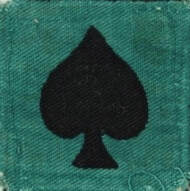 25th Indian Infantry Divison insignia.
25th Indian Infantry Divison insignia.
Having returned to India after just a few weeks behind Japanese lines, Lt. Green was given the role of Rear Party commander for the 3/2 Gurkha Rifles. Performing liaison and administrative duties, he arranged medical aid for the sick and wounded Gurkhas at the casualty clearing station in Imphal. He also recorded witness statements from the returning Gurkha Riflemen for soldiers that had either been killed or were now listed as missing.
In June 1943, Green was sent to Calcutta on regimental related duties. On his return the remnants of the 3/2 Gurkha battalion made their way from Imphal to their regimental centre at Dehra Dun. It was from here that the men went on recuperation leave before the battalion was reorganised and brought back up to strength.
3/2 Gurkha Rifles then joined up to form part of the 25th Indian Infantry Division and were sent to the Arakan region of Burma to begin removing the Japanese from this location. In June 1944, Lt. Green was leading the battalion's forward reconnaissance platoon, working alongside V Force in plotting the enemy's positions and strength. He then left the battalion on compassionate grounds and went home to the United Kingdom. On his return to India he was posted to the 5th battalion of the 2nd Gurkha Rifles and went on to serve on the North West Frontier with this unit until leaving the Indian Army at the end of the war.
Fellow Gurkha Rifles officer, Nick Neill became great friends with Ronald Green during their time together on the first Wingate expedition and again in the Arakan. Neill described Green as being a wonderful character and a very good soldier. He said that he had last seen his friend in 1963 at the 25th Indian Division annual reunion in London and that Ronnie Green had sadly died not long afterwards.
In June 1943, Green was sent to Calcutta on regimental related duties. On his return the remnants of the 3/2 Gurkha battalion made their way from Imphal to their regimental centre at Dehra Dun. It was from here that the men went on recuperation leave before the battalion was reorganised and brought back up to strength.
3/2 Gurkha Rifles then joined up to form part of the 25th Indian Infantry Division and were sent to the Arakan region of Burma to begin removing the Japanese from this location. In June 1944, Lt. Green was leading the battalion's forward reconnaissance platoon, working alongside V Force in plotting the enemy's positions and strength. He then left the battalion on compassionate grounds and went home to the United Kingdom. On his return to India he was posted to the 5th battalion of the 2nd Gurkha Rifles and went on to serve on the North West Frontier with this unit until leaving the Indian Army at the end of the war.
Fellow Gurkha Rifles officer, Nick Neill became great friends with Ronald Green during their time together on the first Wingate expedition and again in the Arakan. Neill described Green as being a wonderful character and a very good soldier. He said that he had last seen his friend in 1963 at the 25th Indian Division annual reunion in London and that Ronnie Green had sadly died not long afterwards.
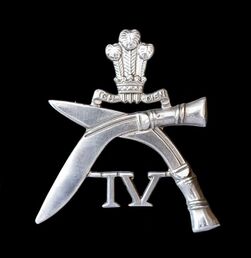 Cap badge of the 4th Gurkha Rifles.
Cap badge of the 4th Gurkha Rifles.
Lt. George Louis Jensen Harvey
George Louis Jensen Harvey was born on the 8th July 1923 and was the son of George and Evelyn Harvey who, at the time of the war were living in Baghdad, Iraq. Lt. Harvey was posted to 77 Brigade in December 1942 from his original unit, the Prince of Wales' Own (4th) Gurkha Rifles. He was allocated to 3/2 Gurkhas at Jhansi and placed into No. 1 Column under the command of Major George Dunlop.
From the No. 1 Column war diary:
As the year (1942) came to an end, 1 Column was brought up to strength with the arrival of some new blood, in the shape of Medical Officer Captain Norman Stocks, RAF Liaison Officer John Redman, the Animal Transport Officer Lt. John Fowler with the rest of the mules, and two young subalterns, 2nd Lieutenants Harvey and Wormell. They had to learn quickly as there were two river-crossing exercises planned and wireless training to be carried out by the newly arrived Signal Section.
Apart from the rigours of training and acclimatising to the new methods installed by Brigadier Wingate at Jhansi, one of George Harvey's first tasks as an officer, was to sit as a board member during a court of enquiry into the accidental death of Lance Corporal Percy Finch. Finch, a member of No. 1 Column's commando platoon had died on the 24th December 1942 (Christmas Eve) as a result of mis-handling explosives. To read more about this incident, please click on the following link: Lance Corporal Percy Finch
Just before Operation Longcloth opened, Major Dunlop and his officers from No. 1 Column were called to Brigade Headquarters at Imphal and given their instructions by Wingate, which were short and very much to the point:
a) Together with No. 2 Column, they were to create a diversion to the south of the main objectives to be performed by Columns 3,4,5,7 and 8 (Northern Group). Their orders were to operate openly in the area to the east of Auktaung in order to draw off as many Japanese patrols as possible.
b) To then meet Brigadier Wingate, in the low ground beyond Tagaung on the east side of the Irrawaddy River in early March. Or, having failed to make this meeting, to travel to Mongmit and encourage a rebellion amongst the Burmese against the Japanese occupation.
As it turned out, Major Dunlop and his men failed to meet Northern Group at the Irrawaddy in March. They and No. 2 Column had engaged the enemy on several occasions that month, most notably at a place called Kyaikthin where No. 2 Column had been ambushed and badly beaten up. As ordered, the remnants of Southern Group headed for Mongmit close to the western banks of the Shweli River. When dispersal was called in late March 1943, they found themselves the furthest east of any of the Chindit columns.
After a failed attempt to exit Burma via the Chinese borders, Dunlop turned his men around and headed westward for the Irrawaddy River. On or about the 20th April they found themselves in the vicinity of Sinhnyat, a small village on the eastern bank of the mile-wide river. At dusk that day the column began to cross in native country boats. All night the boats plied back and forth carrying 20 or so men each trip. By dawn there were just two more journeys required, but just as these set off the Japanese appeared on the western side and opened up across the river with machine guns and mortars. The last two boats never began their journey and disappeared back in to the jungle scrub at Sinhnyat. Those left behind at Sinhnyat included the Medical Officer, Doctor George Lusk, RAF Liaison officer John Redman and George Harvey who had volunteered to take command of the rear party.
Nothing was heard again of the rear party and their names were placed on the missing lists for Operation Longcloth. Then in May 1945, the soldiers from the first Wingate expedition who had been taken prisoner during the operation were released from Rangoon Jail. Amongst other statements, they recounted that after the ambush at the Irrawaddy, the rear party from No. 1 Column had stumbled into another Japanese patrol resulting in Doc Lusk and John Redman being wounded and lost to the group. Both these men ultimately succumbed to their woulds and perished shortly afterwards. Lt. Harvey managed to evade the enemy at this point, but some weeks later was captured on the 24th May 1943 and sent down to Rangoon, where he spent the next two years at the city jail.
George Harvey shared a prison cell with many of the officers captured on Operation Longcloth, including fellow 4th Gurkha Rifles officer, Robert Peter Wormell who had also ben captured as a result of the compromised crossing of the Irrawaddy River on the 20th April 1943. The POWs at Rangoon Jail were made to perform manual labour, mostly in the form of heavy lifting at the local docks, or clearing away the rubble from bomb-damaged buildings. On the 29th April 1945, George Harvey and around 400 other prisoners were liberated at a Burmese village named Was on the Pegu Road. Seen below is an image of George's POW index card, showing his date of capture, next of kin details and his POW number (39).
George Louis Jensen Harvey was born on the 8th July 1923 and was the son of George and Evelyn Harvey who, at the time of the war were living in Baghdad, Iraq. Lt. Harvey was posted to 77 Brigade in December 1942 from his original unit, the Prince of Wales' Own (4th) Gurkha Rifles. He was allocated to 3/2 Gurkhas at Jhansi and placed into No. 1 Column under the command of Major George Dunlop.
From the No. 1 Column war diary:
As the year (1942) came to an end, 1 Column was brought up to strength with the arrival of some new blood, in the shape of Medical Officer Captain Norman Stocks, RAF Liaison Officer John Redman, the Animal Transport Officer Lt. John Fowler with the rest of the mules, and two young subalterns, 2nd Lieutenants Harvey and Wormell. They had to learn quickly as there were two river-crossing exercises planned and wireless training to be carried out by the newly arrived Signal Section.
Apart from the rigours of training and acclimatising to the new methods installed by Brigadier Wingate at Jhansi, one of George Harvey's first tasks as an officer, was to sit as a board member during a court of enquiry into the accidental death of Lance Corporal Percy Finch. Finch, a member of No. 1 Column's commando platoon had died on the 24th December 1942 (Christmas Eve) as a result of mis-handling explosives. To read more about this incident, please click on the following link: Lance Corporal Percy Finch
Just before Operation Longcloth opened, Major Dunlop and his officers from No. 1 Column were called to Brigade Headquarters at Imphal and given their instructions by Wingate, which were short and very much to the point:
a) Together with No. 2 Column, they were to create a diversion to the south of the main objectives to be performed by Columns 3,4,5,7 and 8 (Northern Group). Their orders were to operate openly in the area to the east of Auktaung in order to draw off as many Japanese patrols as possible.
b) To then meet Brigadier Wingate, in the low ground beyond Tagaung on the east side of the Irrawaddy River in early March. Or, having failed to make this meeting, to travel to Mongmit and encourage a rebellion amongst the Burmese against the Japanese occupation.
As it turned out, Major Dunlop and his men failed to meet Northern Group at the Irrawaddy in March. They and No. 2 Column had engaged the enemy on several occasions that month, most notably at a place called Kyaikthin where No. 2 Column had been ambushed and badly beaten up. As ordered, the remnants of Southern Group headed for Mongmit close to the western banks of the Shweli River. When dispersal was called in late March 1943, they found themselves the furthest east of any of the Chindit columns.
After a failed attempt to exit Burma via the Chinese borders, Dunlop turned his men around and headed westward for the Irrawaddy River. On or about the 20th April they found themselves in the vicinity of Sinhnyat, a small village on the eastern bank of the mile-wide river. At dusk that day the column began to cross in native country boats. All night the boats plied back and forth carrying 20 or so men each trip. By dawn there were just two more journeys required, but just as these set off the Japanese appeared on the western side and opened up across the river with machine guns and mortars. The last two boats never began their journey and disappeared back in to the jungle scrub at Sinhnyat. Those left behind at Sinhnyat included the Medical Officer, Doctor George Lusk, RAF Liaison officer John Redman and George Harvey who had volunteered to take command of the rear party.
Nothing was heard again of the rear party and their names were placed on the missing lists for Operation Longcloth. Then in May 1945, the soldiers from the first Wingate expedition who had been taken prisoner during the operation were released from Rangoon Jail. Amongst other statements, they recounted that after the ambush at the Irrawaddy, the rear party from No. 1 Column had stumbled into another Japanese patrol resulting in Doc Lusk and John Redman being wounded and lost to the group. Both these men ultimately succumbed to their woulds and perished shortly afterwards. Lt. Harvey managed to evade the enemy at this point, but some weeks later was captured on the 24th May 1943 and sent down to Rangoon, where he spent the next two years at the city jail.
George Harvey shared a prison cell with many of the officers captured on Operation Longcloth, including fellow 4th Gurkha Rifles officer, Robert Peter Wormell who had also ben captured as a result of the compromised crossing of the Irrawaddy River on the 20th April 1943. The POWs at Rangoon Jail were made to perform manual labour, mostly in the form of heavy lifting at the local docks, or clearing away the rubble from bomb-damaged buildings. On the 29th April 1945, George Harvey and around 400 other prisoners were liberated at a Burmese village named Was on the Pegu Road. Seen below is an image of George's POW index card, showing his date of capture, next of kin details and his POW number (39).
After his liberation, George Harvey returned to his former regiment, the Prince of Wales' Own (4th) Gurkha Rifles and over the following years rose to the rank of Major. Post war, he became a member of the Burma Star Association, living by the mid-1950s firstly in Bangalore (India) and then Western Australia.
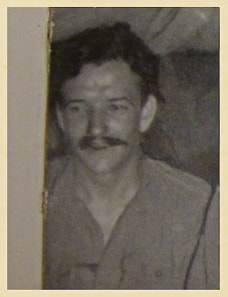 Alexander Irving in 1944.
Alexander Irving in 1944.
Lt. Alexander Irving
Very little is known about Lt. Alexander Irving (Army no. EC6426) and his experiences on Operation Longcloth. He came to 77 Brigade from the ranks of 3/2 Gurkha Rifles and was allocated to No. 7 Column as the units Animal Transport Officer. Alex is not mentioned in any of the books written about the first Wingate Expedition, but we do know from the 7 Column war diary, that he exited Burma in April/May 1943 via the Chinese borders.
An entry in the diary for 5th June 1943, mentions that Lt. Irving, having made the arduous journey out of Burma was present at the Chinese town of Paoshan. He had just recently arrived at Paoshan, and was tasked alongside Captain Harold Blackburne with remaining in the town and collecting together all the stragglers from 7 Column as they came in. Most of the earlier arrivals from Major Gilkes' column had now left Paoshan for Kunming where they were being flown back to India by Untied States Army Air Force transporter aircraft.
By September 1943, Alex Irving and the 3/2 Gurkha Rifles had been re-formed and returned to War Establishment strength. In October the battalion, now under the command of Reggie Hutton and Philip Panton, moved to Conjeeveram, a town just outside of Madras. It was here that they began their jungle warfare training in preparation for the new campaign season due to begin in early 1944. By late February they had congregated in Calcutta, ready for their move down to Chittagong. On the 21st March 1944 the battalion became a component of the 74th Indian Infantry Brigade, part of the 25th Indian Division and tasked to eject the Japanese from the Arakan region of Burma. Alex Irving fought with many of his old comrades from the first Chindit Expedition in the Arakan, men such as Lts. Dominic Neill, Bertie Birtwhistle and Richard Scamander Clarke. The fighting in this region was tough, not just against a well-dug-in enemy, but also leeches, malaria and monsoon rains.
Alex fought with the 3/2 Gurkhas for the remainder of the war, rising to the rank of Major and taking part on Operation Zipper, the landings in Malaya after the Japanese had surrendered in August 1945. After the war he returned to Scotland and lived in Hecklegirth, Dumfriesshire. He was also a member of the Burma Star Association, occasionally attending branch meetings in Carlisle.
Seen below is a photograph of a group of 3/2 Gurkha Rifles officers in the Arakan region of Burma in 1944. Please click on the image to bring it forward on the page.
Very little is known about Lt. Alexander Irving (Army no. EC6426) and his experiences on Operation Longcloth. He came to 77 Brigade from the ranks of 3/2 Gurkha Rifles and was allocated to No. 7 Column as the units Animal Transport Officer. Alex is not mentioned in any of the books written about the first Wingate Expedition, but we do know from the 7 Column war diary, that he exited Burma in April/May 1943 via the Chinese borders.
An entry in the diary for 5th June 1943, mentions that Lt. Irving, having made the arduous journey out of Burma was present at the Chinese town of Paoshan. He had just recently arrived at Paoshan, and was tasked alongside Captain Harold Blackburne with remaining in the town and collecting together all the stragglers from 7 Column as they came in. Most of the earlier arrivals from Major Gilkes' column had now left Paoshan for Kunming where they were being flown back to India by Untied States Army Air Force transporter aircraft.
By September 1943, Alex Irving and the 3/2 Gurkha Rifles had been re-formed and returned to War Establishment strength. In October the battalion, now under the command of Reggie Hutton and Philip Panton, moved to Conjeeveram, a town just outside of Madras. It was here that they began their jungle warfare training in preparation for the new campaign season due to begin in early 1944. By late February they had congregated in Calcutta, ready for their move down to Chittagong. On the 21st March 1944 the battalion became a component of the 74th Indian Infantry Brigade, part of the 25th Indian Division and tasked to eject the Japanese from the Arakan region of Burma. Alex Irving fought with many of his old comrades from the first Chindit Expedition in the Arakan, men such as Lts. Dominic Neill, Bertie Birtwhistle and Richard Scamander Clarke. The fighting in this region was tough, not just against a well-dug-in enemy, but also leeches, malaria and monsoon rains.
Alex fought with the 3/2 Gurkhas for the remainder of the war, rising to the rank of Major and taking part on Operation Zipper, the landings in Malaya after the Japanese had surrendered in August 1945. After the war he returned to Scotland and lived in Hecklegirth, Dumfriesshire. He was also a member of the Burma Star Association, occasionally attending branch meetings in Carlisle.
Seen below is a photograph of a group of 3/2 Gurkha Rifles officers in the Arakan region of Burma in 1944. Please click on the image to bring it forward on the page.
Naik 7215 Jit Ram Thapa
This Gurkha was a member of No. 1 Column on Operation Longcloth under the command of Major George Dunlop MC of the Royal Scots. He was killed on the 22nd April 1943, as the remnants of Southern Section, led by Dunlop and Colonel Alexander were attempting to regain Allied held territory on the return journey to India. According to anecdotal testimony from that time, Jit Ram Thapa was killed in one of the very last boats to make the final crossing of the Irrawaddy River (east to west) on the 22nd April, when a Japanese mounted machine gun opened up from the western bank. His body was never found and for this reason he is remembered upon Face 57 of the Rangoon Memorial at Taukkyan War Cemetery.
This Gurkha was a member of No. 1 Column on Operation Longcloth under the command of Major George Dunlop MC of the Royal Scots. He was killed on the 22nd April 1943, as the remnants of Southern Section, led by Dunlop and Colonel Alexander were attempting to regain Allied held territory on the return journey to India. According to anecdotal testimony from that time, Jit Ram Thapa was killed in one of the very last boats to make the final crossing of the Irrawaddy River (east to west) on the 22nd April, when a Japanese mounted machine gun opened up from the western bank. His body was never found and for this reason he is remembered upon Face 57 of the Rangoon Memorial at Taukkyan War Cemetery.
Naik Khembahadur Pun and Rifleman Kharaksing Thapa were soldiers from No. 2 Column that survived their time on Operation Longcloth. Both men returned to India after the expedition and were reunited with their platoon commander, Lt. Ian MacHorton, at the battalion regimental centre in Dehra Dun.
Rifleman 29139 Khime Kanwar was taken prisoner during Operation Longcloth whilst serving with No. 3 Column in Burma. He was later recognised in Rangoon Jail by his platoon commander, Lt. Alec Gibson. Sadly, this Gurkha did not survive his time as a prisoner of war and perished on 5th March 1945.
Lance Naik Khite Thapa served with No. 1 Column in Burma. He successfully made his way back to India in May 1943, swimming the Chindwin alongside his commander, Major Dunlop and fellow Gurkha NCO, Lance Naik Manlur Thapa.
Riflemen Lachiman Limbu and Dev Singh both served with No. 1 Column on Operation Longcloth and both became prisoners of war during the latter weeks of the expedition. It is reported that both men escaped their captors after a few weeks incarceration at a camp near Mandalay. On many occasions, Gurkhas captured by the Japanese during Longcloth were employed as mule handlers, taking supplies up to the front line in preparation of what was to become the march on Imphal and Kohima the following year.
Rifleman 29139 Khime Kanwar was taken prisoner during Operation Longcloth whilst serving with No. 3 Column in Burma. He was later recognised in Rangoon Jail by his platoon commander, Lt. Alec Gibson. Sadly, this Gurkha did not survive his time as a prisoner of war and perished on 5th March 1945.
Lance Naik Khite Thapa served with No. 1 Column in Burma. He successfully made his way back to India in May 1943, swimming the Chindwin alongside his commander, Major Dunlop and fellow Gurkha NCO, Lance Naik Manlur Thapa.
Riflemen Lachiman Limbu and Dev Singh both served with No. 1 Column on Operation Longcloth and both became prisoners of war during the latter weeks of the expedition. It is reported that both men escaped their captors after a few weeks incarceration at a camp near Mandalay. On many occasions, Gurkhas captured by the Japanese during Longcloth were employed as mule handlers, taking supplies up to the front line in preparation of what was to become the march on Imphal and Kohima the following year.
Naik 7029 Kharak Bin Rana and Rifleman Kulbir Pun were part of No. 2 Column during the first Wingate expedition in 1943. According to Subedar-Major Siblal Thapa, both men had to be left behind after being wounded during the battle with the enemy at Kyaikthin. Siblal Thapa remembered:
We had skirted the Japs and continued to move through very difficulty country with deep nullahs and steady hills. We stopped eventually in the dense jungle for a rest and to reconnoitre the railway station up ahead. Before we could prepare for our own attack we were ambushed by the enemy and fought running battles with them for over an hour. After this the dispersal signal could be heard and we moved away from the scene towards the pre-arranged rendezvous position. I spent all day on March 2nd, rounding up our stragglers and checking over the battle area. Seven of my men had been killed and two wounded. We could not recover the bodies of the dead, but supported the wounded: Kharak Bin Rana, gun shot wound to right arm and Kulbir Pun, multiple wounds to legs and body from mortar fragments. I gave these men 20 rupees each and told them to try and find shelter in the nearest village. I never saw the wounded men again.
We had skirted the Japs and continued to move through very difficulty country with deep nullahs and steady hills. We stopped eventually in the dense jungle for a rest and to reconnoitre the railway station up ahead. Before we could prepare for our own attack we were ambushed by the enemy and fought running battles with them for over an hour. After this the dispersal signal could be heard and we moved away from the scene towards the pre-arranged rendezvous position. I spent all day on March 2nd, rounding up our stragglers and checking over the battle area. Seven of my men had been killed and two wounded. We could not recover the bodies of the dead, but supported the wounded: Kharak Bin Rana, gun shot wound to right arm and Kulbir Pun, multiple wounds to legs and body from mortar fragments. I gave these men 20 rupees each and told them to try and find shelter in the nearest village. I never saw the wounded men again.
Rifleman 10175 Tahal Sing Thapa, a range finder with No. 3 Column Mortar Platoon was killed on the 14th March 1943, during a rearguard action against the Japanese at Daunggyi Chaung. Fellow Gurkha, Naik 7391 Lal Suba Gurung was also killed at this location as the column attempted their first crossing of the Irrawaddy River during Operation Longcloth.
Jemadar 5846 Makan Sing Gurung from No. 1 Column was listed as missing on the 5th April 1943, during the column's marching period close to the Mong Mit-Myitson Road. Sadly, he was never seen or heard of again.
Captain Charles Francis Legh served with 3/2 Gurkhas in late 1942 and possibly on Operation Longcloth. He was attached to 3/2 GR from 1/10 Gurkhas, probably in relation to the large draft of 300 mule-handlers from that battalion as reinforcements for 77 Brigade in January 1943.
Jemadar Mehan Sing Gurung served with Southern Group Head Quarters on the first Wingate expedition and was at the forefront of the fighting with the Japanese at Nam Pan Hill in mid-March 1943. Another soldier who fought in the same engagement was Jemadar Nama Sing Gurung from No. 1 Column.
Water Carrier/Bearer Mukerjee fought with No. 1 Column on Operation Longcloth and made the long and arduous return journey to India in May 1943, swimming the Chindwin River alongside his commander Major George Dunlop.
Lance Naik Narsuba Gurung was part of a special reconnaissance patrol that surveyed potential crossing points at the Chindwin River in November 1942. On his return this Gurkha NCO was allocated to No. 1 Column and served throughout the first Wingate expedition with this unit.
Rifleman Par Bahadur Thapa was captured during Operation Longcloth whilst serving with No. 1 Column. He perished as a POW on 30th July 1943 when an Allied bombing raid destroyed the camp he was being held in at Kalewa.
Rifleman 26119 Pemba Dorje Tamang was killed whilst serving with No. 1 Column on the return crossing of the Irrawaddy River on the 22nd April 1943. This soldier is now remembered upon Face 58 of the Rangoon Memorial at Taukkyan War Cemetery.
Rifleman Pithm Bahadur was Major George Dunlop's orderly on Operation Longcloth and is mentioned in his commander's memoir for attempting to keep up morale on the final part of No. 1 Column's return to the Chindwin River in early May 1943.
Rifleman 10174 Prem Bahadur Rana was a soldier with No. 2 Column on the first Chindit expedition and sadly lost his life on the 3rd March 1943 after the ambush at Kyaikthin.
Lance Naik Rattan Singh was a soldier with No. 1 Column in Burma and was taken prisoner during the latter stages of Operation Longcloth and held at the Kalewa POW Camp. To read more about his experiences as a prisoner of war, please click on the following link and read the seven-page uploaded report: The Miraculous Return of Aita Sing Gurung
Sweeper F/233 Shamsher was the son of Harnam and Mukandi from Hagal in Dehra Dun. This soldier took part on the first Wingate expedition and although it is thought that he survived his time in Burma and returned to India, he sadly died from wounds sustained on the expedition on the 30th June 1943. However, the fact that Shamsher is remembered upon Face 58 of the Rangoon Memorial, I wonder if he did make it out of Burma during Operation Longcloth after all?
Lieutenant A.H. Strickland served with 3/2 Gurkha Rifles at the Saugor training camp in late 1942 and was ordered to escort a mule conducting party on the 18th November that year, destination Jullundur. Please see image below.
Jemadar 5846 Makan Sing Gurung from No. 1 Column was listed as missing on the 5th April 1943, during the column's marching period close to the Mong Mit-Myitson Road. Sadly, he was never seen or heard of again.
Captain Charles Francis Legh served with 3/2 Gurkhas in late 1942 and possibly on Operation Longcloth. He was attached to 3/2 GR from 1/10 Gurkhas, probably in relation to the large draft of 300 mule-handlers from that battalion as reinforcements for 77 Brigade in January 1943.
Jemadar Mehan Sing Gurung served with Southern Group Head Quarters on the first Wingate expedition and was at the forefront of the fighting with the Japanese at Nam Pan Hill in mid-March 1943. Another soldier who fought in the same engagement was Jemadar Nama Sing Gurung from No. 1 Column.
Water Carrier/Bearer Mukerjee fought with No. 1 Column on Operation Longcloth and made the long and arduous return journey to India in May 1943, swimming the Chindwin River alongside his commander Major George Dunlop.
Lance Naik Narsuba Gurung was part of a special reconnaissance patrol that surveyed potential crossing points at the Chindwin River in November 1942. On his return this Gurkha NCO was allocated to No. 1 Column and served throughout the first Wingate expedition with this unit.
Rifleman Par Bahadur Thapa was captured during Operation Longcloth whilst serving with No. 1 Column. He perished as a POW on 30th July 1943 when an Allied bombing raid destroyed the camp he was being held in at Kalewa.
Rifleman 26119 Pemba Dorje Tamang was killed whilst serving with No. 1 Column on the return crossing of the Irrawaddy River on the 22nd April 1943. This soldier is now remembered upon Face 58 of the Rangoon Memorial at Taukkyan War Cemetery.
Rifleman Pithm Bahadur was Major George Dunlop's orderly on Operation Longcloth and is mentioned in his commander's memoir for attempting to keep up morale on the final part of No. 1 Column's return to the Chindwin River in early May 1943.
Rifleman 10174 Prem Bahadur Rana was a soldier with No. 2 Column on the first Chindit expedition and sadly lost his life on the 3rd March 1943 after the ambush at Kyaikthin.
Lance Naik Rattan Singh was a soldier with No. 1 Column in Burma and was taken prisoner during the latter stages of Operation Longcloth and held at the Kalewa POW Camp. To read more about his experiences as a prisoner of war, please click on the following link and read the seven-page uploaded report: The Miraculous Return of Aita Sing Gurung
Sweeper F/233 Shamsher was the son of Harnam and Mukandi from Hagal in Dehra Dun. This soldier took part on the first Wingate expedition and although it is thought that he survived his time in Burma and returned to India, he sadly died from wounds sustained on the expedition on the 30th June 1943. However, the fact that Shamsher is remembered upon Face 58 of the Rangoon Memorial, I wonder if he did make it out of Burma during Operation Longcloth after all?
Lieutenant A.H. Strickland served with 3/2 Gurkha Rifles at the Saugor training camp in late 1942 and was ordered to escort a mule conducting party on the 18th November that year, destination Jullundur. Please see image below.
Rifleman Tekbahadur Gurung was a soldier with No. 2 Column on Operation Longcloth and was reported missing after the engagement with the Japanese at Kyaikthin. He was later discovered to be a prisoner of war at the Kalaw Camp and it is thought that he survived this experience and returned home after liberation.
Havildar-Major Tekbahadur Pun served with No. 1 Column in Burma and was captured by the Japanese whilst crossing the Irrawaddy River on the 22nd April 1943. Nothing more is known about this soldier.
Havildar 1909 Telbir Thapa was killed in action whilst serving with No. 1 Column in Burma. He perished on the 23rd March 1943 as his column approached the area around Nam Mit.
Lance Naik Thagbahadur Thapa was wounded at the Daunggyi Chaung whilst serving as rearguard for No. 3 Column, as they crossed the Irrawaddy River on their outward journey during Operation Longcloth. This man survived the expedition and returned to India in April that same year.
Naik 7276 Tikaram Thapa served with No. 2 Column during the first Wingate expedition and returned safely to India after the ambush at Kyaikthin on March 2nd 1943. In 1944, he was awarded a Mention in Despatches for his efforts in the Arakan region of Burma with 3/2 Gurkha Rifles.
Rifleman 65193 Tiribahadur Pun took part on Operation Longcloth and was captured at some point during the expedition. He is reported to have
escaped from his Japanese captors in May 1944 and made his own way back to Allied held territory.
Rifleman 26056 Tulbahadur Gurung of No. 1 Column on Operation Longcloth, was tragically killed when an Allied bombing raid destroyed the camp he was being held in at Kalewa.
Orderly Wankap Sahmi was taken prisoner during the first Wingate expedition, but then remarkably liberated by 77 Brigade in June 1944, during Operation Thursday.
Havildar-Major Tekbahadur Pun served with No. 1 Column in Burma and was captured by the Japanese whilst crossing the Irrawaddy River on the 22nd April 1943. Nothing more is known about this soldier.
Havildar 1909 Telbir Thapa was killed in action whilst serving with No. 1 Column in Burma. He perished on the 23rd March 1943 as his column approached the area around Nam Mit.
Lance Naik Thagbahadur Thapa was wounded at the Daunggyi Chaung whilst serving as rearguard for No. 3 Column, as they crossed the Irrawaddy River on their outward journey during Operation Longcloth. This man survived the expedition and returned to India in April that same year.
Naik 7276 Tikaram Thapa served with No. 2 Column during the first Wingate expedition and returned safely to India after the ambush at Kyaikthin on March 2nd 1943. In 1944, he was awarded a Mention in Despatches for his efforts in the Arakan region of Burma with 3/2 Gurkha Rifles.
Rifleman 65193 Tiribahadur Pun took part on Operation Longcloth and was captured at some point during the expedition. He is reported to have
escaped from his Japanese captors in May 1944 and made his own way back to Allied held territory.
Rifleman 26056 Tulbahadur Gurung of No. 1 Column on Operation Longcloth, was tragically killed when an Allied bombing raid destroyed the camp he was being held in at Kalewa.
Orderly Wankap Sahmi was taken prisoner during the first Wingate expedition, but then remarkably liberated by 77 Brigade in June 1944, during Operation Thursday.
